Computerized Accounting in ERP: Benefits of SAP S/4 HANA Finance for Business
VerifiedAdded on 2023/06/11
|19
|4755
|431
AI Summary
This report discusses the benefits of SAP S/4 HANA Finance for businesses, including its historical overview, the difference between current SAP ERP FICO and SAP/S 4 HANA, and case studies of companies that have migrated to SAP/S 4 HANA Finance. The report explains how SAP S/4 HANA Finance enhances efficiency, supports decision making, saves IT costs, enables efficient collaboration, enhances productivity, provides accelerated financial close, and allows for parallel valuation of assets. The report also discusses the challenges of migrating to SAP/S 4 HANA Finance and the different migration options available to businesses.
Contribute Materials
Your contribution can guide someone’s learning journey. Share your
documents today.
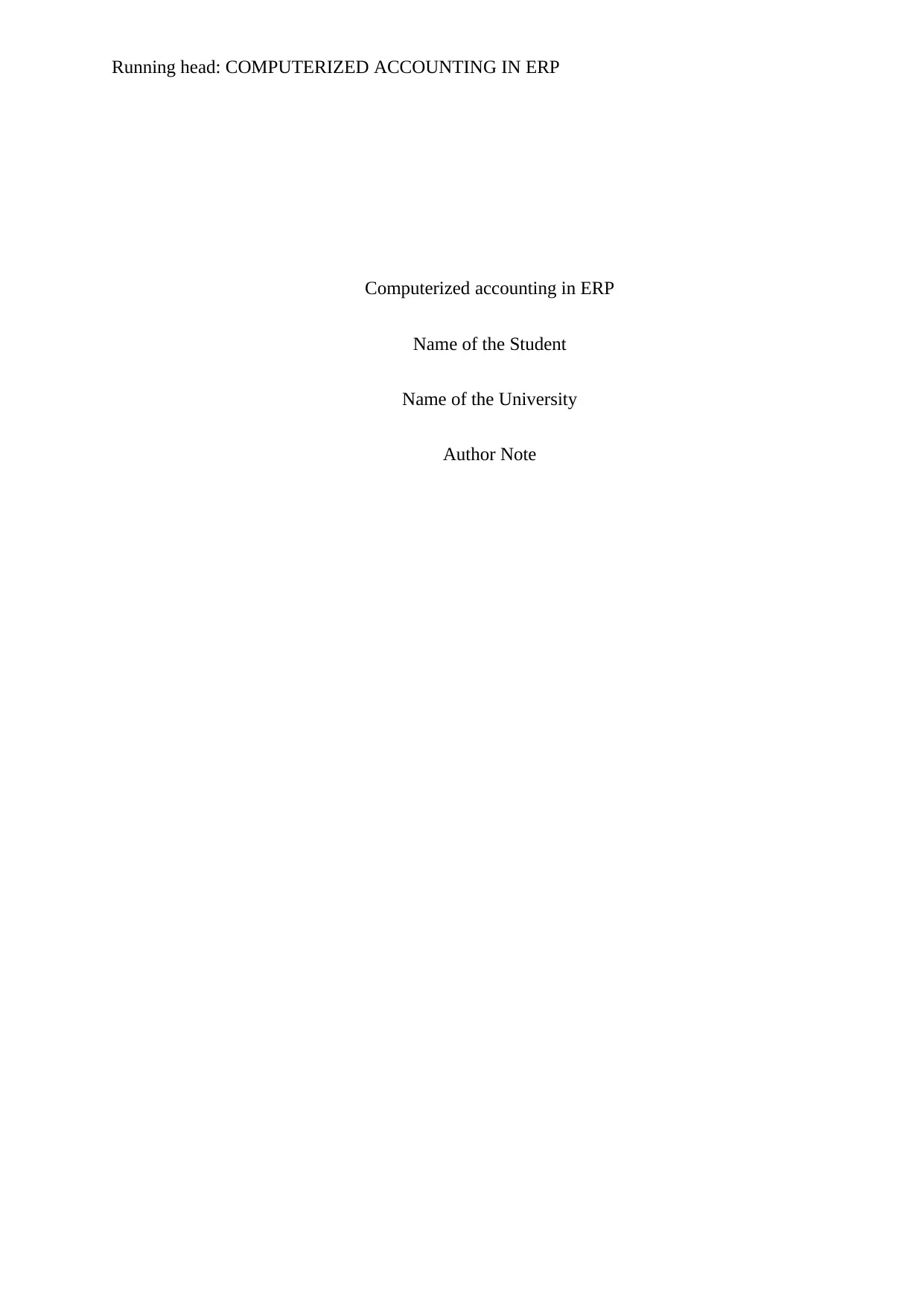
Running head: COMPUTERIZED ACCOUNTING IN ERP
Computerized accounting in ERP
Name of the Student
Name of the University
Author Note
Computerized accounting in ERP
Name of the Student
Name of the University
Author Note
Secure Best Marks with AI Grader
Need help grading? Try our AI Grader for instant feedback on your assignments.
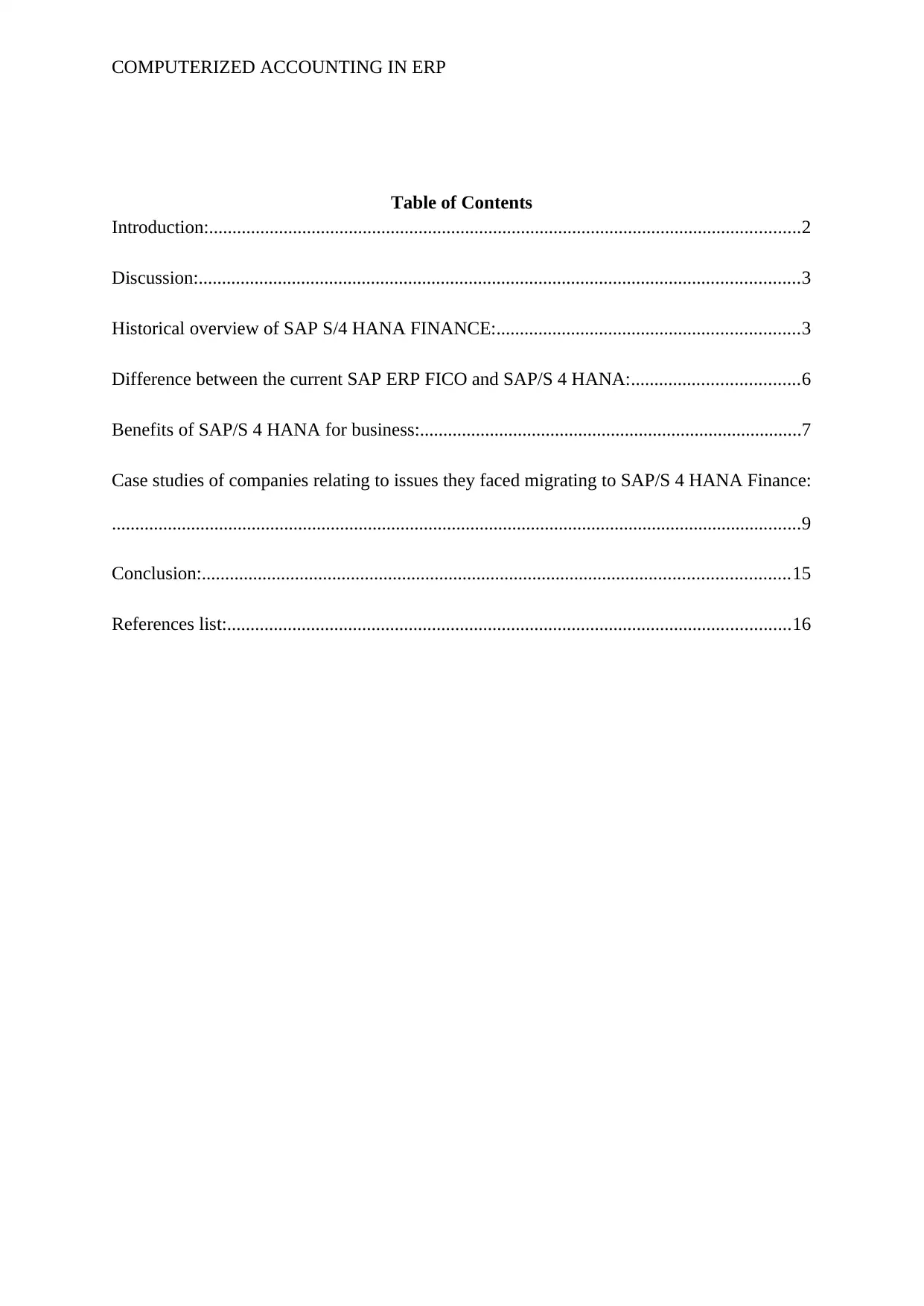
COMPUTERIZED ACCOUNTING IN ERP
Table of Contents
Introduction:...............................................................................................................................2
Discussion:.................................................................................................................................3
Historical overview of SAP S/4 HANA FINANCE:.................................................................3
Difference between the current SAP ERP FICO and SAP/S 4 HANA:....................................6
Benefits of SAP/S 4 HANA for business:..................................................................................7
Case studies of companies relating to issues they faced migrating to SAP/S 4 HANA Finance:
....................................................................................................................................................9
Conclusion:..............................................................................................................................15
References list:.........................................................................................................................16
Table of Contents
Introduction:...............................................................................................................................2
Discussion:.................................................................................................................................3
Historical overview of SAP S/4 HANA FINANCE:.................................................................3
Difference between the current SAP ERP FICO and SAP/S 4 HANA:....................................6
Benefits of SAP/S 4 HANA for business:..................................................................................7
Case studies of companies relating to issues they faced migrating to SAP/S 4 HANA Finance:
....................................................................................................................................................9
Conclusion:..............................................................................................................................15
References list:.........................................................................................................................16
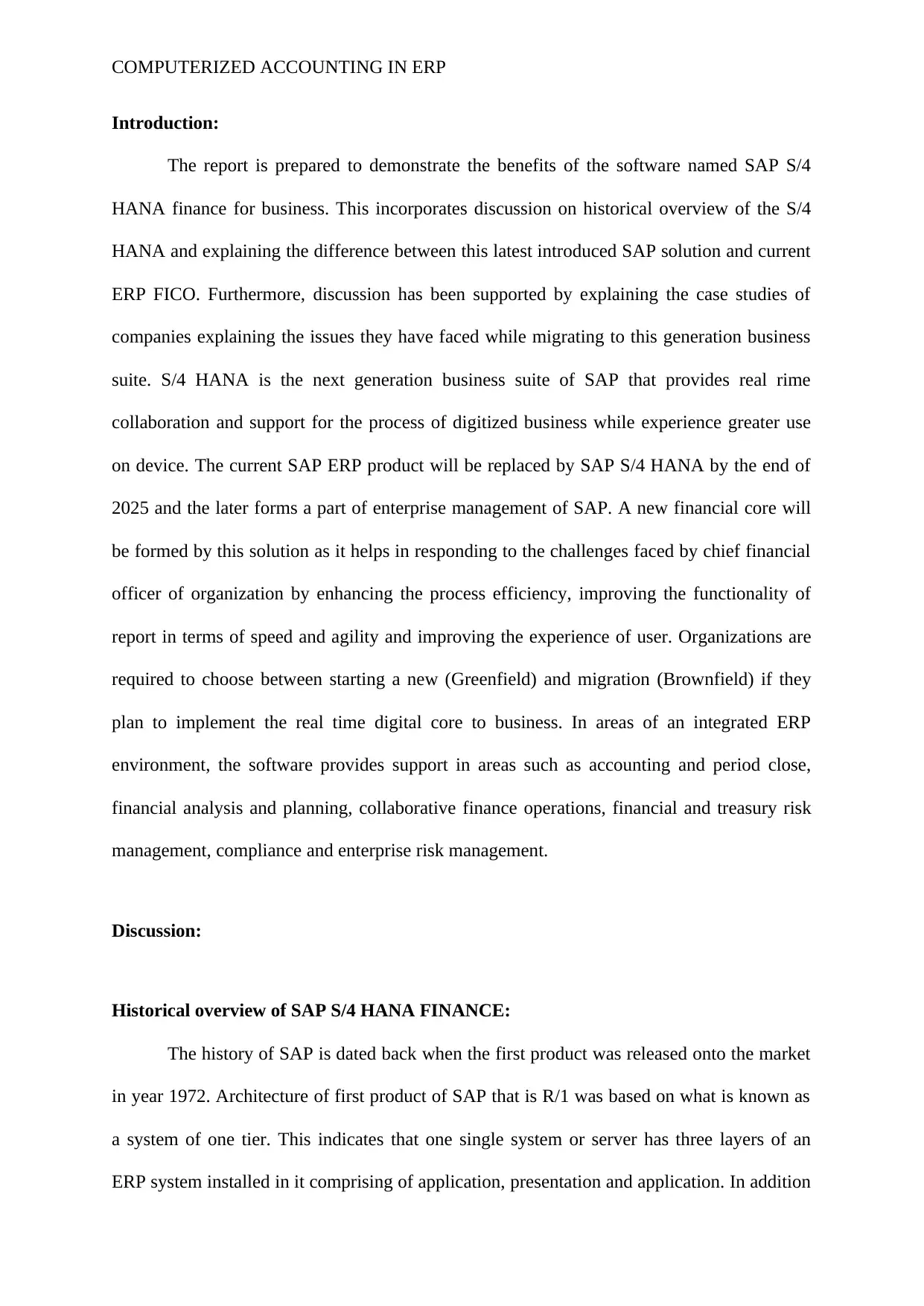
COMPUTERIZED ACCOUNTING IN ERP
Introduction:
The report is prepared to demonstrate the benefits of the software named SAP S/4
HANA finance for business. This incorporates discussion on historical overview of the S/4
HANA and explaining the difference between this latest introduced SAP solution and current
ERP FICO. Furthermore, discussion has been supported by explaining the case studies of
companies explaining the issues they have faced while migrating to this generation business
suite. S/4 HANA is the next generation business suite of SAP that provides real rime
collaboration and support for the process of digitized business while experience greater use
on device. The current SAP ERP product will be replaced by SAP S/4 HANA by the end of
2025 and the later forms a part of enterprise management of SAP. A new financial core will
be formed by this solution as it helps in responding to the challenges faced by chief financial
officer of organization by enhancing the process efficiency, improving the functionality of
report in terms of speed and agility and improving the experience of user. Organizations are
required to choose between starting a new (Greenfield) and migration (Brownfield) if they
plan to implement the real time digital core to business. In areas of an integrated ERP
environment, the software provides support in areas such as accounting and period close,
financial analysis and planning, collaborative finance operations, financial and treasury risk
management, compliance and enterprise risk management.
Discussion:
Historical overview of SAP S/4 HANA FINANCE:
The history of SAP is dated back when the first product was released onto the market
in year 1972. Architecture of first product of SAP that is R/1 was based on what is known as
a system of one tier. This indicates that one single system or server has three layers of an
ERP system installed in it comprising of application, presentation and application. In addition
Introduction:
The report is prepared to demonstrate the benefits of the software named SAP S/4
HANA finance for business. This incorporates discussion on historical overview of the S/4
HANA and explaining the difference between this latest introduced SAP solution and current
ERP FICO. Furthermore, discussion has been supported by explaining the case studies of
companies explaining the issues they have faced while migrating to this generation business
suite. S/4 HANA is the next generation business suite of SAP that provides real rime
collaboration and support for the process of digitized business while experience greater use
on device. The current SAP ERP product will be replaced by SAP S/4 HANA by the end of
2025 and the later forms a part of enterprise management of SAP. A new financial core will
be formed by this solution as it helps in responding to the challenges faced by chief financial
officer of organization by enhancing the process efficiency, improving the functionality of
report in terms of speed and agility and improving the experience of user. Organizations are
required to choose between starting a new (Greenfield) and migration (Brownfield) if they
plan to implement the real time digital core to business. In areas of an integrated ERP
environment, the software provides support in areas such as accounting and period close,
financial analysis and planning, collaborative finance operations, financial and treasury risk
management, compliance and enterprise risk management.
Discussion:
Historical overview of SAP S/4 HANA FINANCE:
The history of SAP is dated back when the first product was released onto the market
in year 1972. Architecture of first product of SAP that is R/1 was based on what is known as
a system of one tier. This indicates that one single system or server has three layers of an
ERP system installed in it comprising of application, presentation and application. In addition

COMPUTERIZED ACCOUNTING IN ERP
to this, the two servers had main version of R/2 product installed in it. R/3 is the latest version
in the era of SAP tier architecture. The most innovative product in the history of SAP is R/3
until year 2012. However, this has been changed with the introduction of HANA and there is
clarified difference between the software’s such as S/4 HANA, S/4 HANA finance and
HANA. S/4 HANA finance is the application for management and financial accounting.
With every version of S/4 HANA release, a simplified and new table structure has
been transformed by more and more functionality. The first application that was launched by
SAP was the S/4 HANA finance for new business suite and the functionality contained in the
application helps organization in accelerating, optimizing and simplification of function of
finance. Along with other solutions in SAP, S/4 HANA finance has its operation on fully
integrated basis and thereby an evolving digital core is provided by SAP.
There are three different components of S/4 HANA of which the functionality has
been discussed in this particular section. Such components comprised of SAP accounting that
is regarded essential, SAP BPC and cash management that are optional.
to this, the two servers had main version of R/2 product installed in it. R/3 is the latest version
in the era of SAP tier architecture. The most innovative product in the history of SAP is R/3
until year 2012. However, this has been changed with the introduction of HANA and there is
clarified difference between the software’s such as S/4 HANA, S/4 HANA finance and
HANA. S/4 HANA finance is the application for management and financial accounting.
With every version of S/4 HANA release, a simplified and new table structure has
been transformed by more and more functionality. The first application that was launched by
SAP was the S/4 HANA finance for new business suite and the functionality contained in the
application helps organization in accelerating, optimizing and simplification of function of
finance. Along with other solutions in SAP, S/4 HANA finance has its operation on fully
integrated basis and thereby an evolving digital core is provided by SAP.
There are three different components of S/4 HANA of which the functionality has
been discussed in this particular section. Such components comprised of SAP accounting that
is regarded essential, SAP BPC and cash management that are optional.
Secure Best Marks with AI Grader
Need help grading? Try our AI Grader for instant feedback on your assignments.
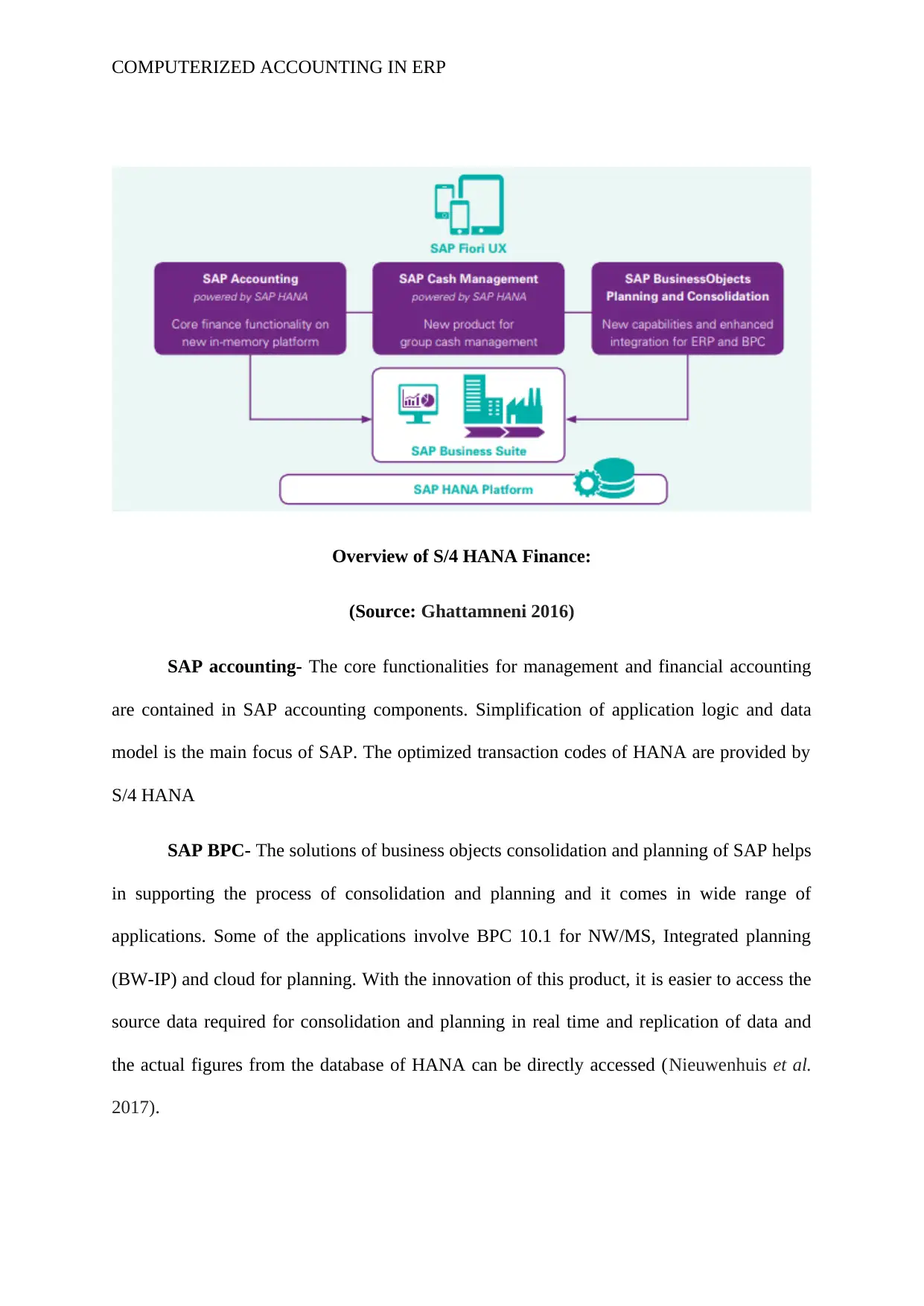
COMPUTERIZED ACCOUNTING IN ERP
Overview of S/4 HANA Finance:
(Source: Ghattamneni 2016)
SAP accounting- The core functionalities for management and financial accounting
are contained in SAP accounting components. Simplification of application logic and data
model is the main focus of SAP. The optimized transaction codes of HANA are provided by
S/4 HANA
SAP BPC- The solutions of business objects consolidation and planning of SAP helps
in supporting the process of consolidation and planning and it comes in wide range of
applications. Some of the applications involve BPC 10.1 for NW/MS, Integrated planning
(BW-IP) and cloud for planning. With the innovation of this product, it is easier to access the
source data required for consolidation and planning in real time and replication of data and
the actual figures from the database of HANA can be directly accessed (Nieuwenhuis et al.
2017).
Overview of S/4 HANA Finance:
(Source: Ghattamneni 2016)
SAP accounting- The core functionalities for management and financial accounting
are contained in SAP accounting components. Simplification of application logic and data
model is the main focus of SAP. The optimized transaction codes of HANA are provided by
S/4 HANA
SAP BPC- The solutions of business objects consolidation and planning of SAP helps
in supporting the process of consolidation and planning and it comes in wide range of
applications. Some of the applications involve BPC 10.1 for NW/MS, Integrated planning
(BW-IP) and cloud for planning. With the innovation of this product, it is easier to access the
source data required for consolidation and planning in real time and replication of data and
the actual figures from the database of HANA can be directly accessed (Nieuwenhuis et al.
2017).
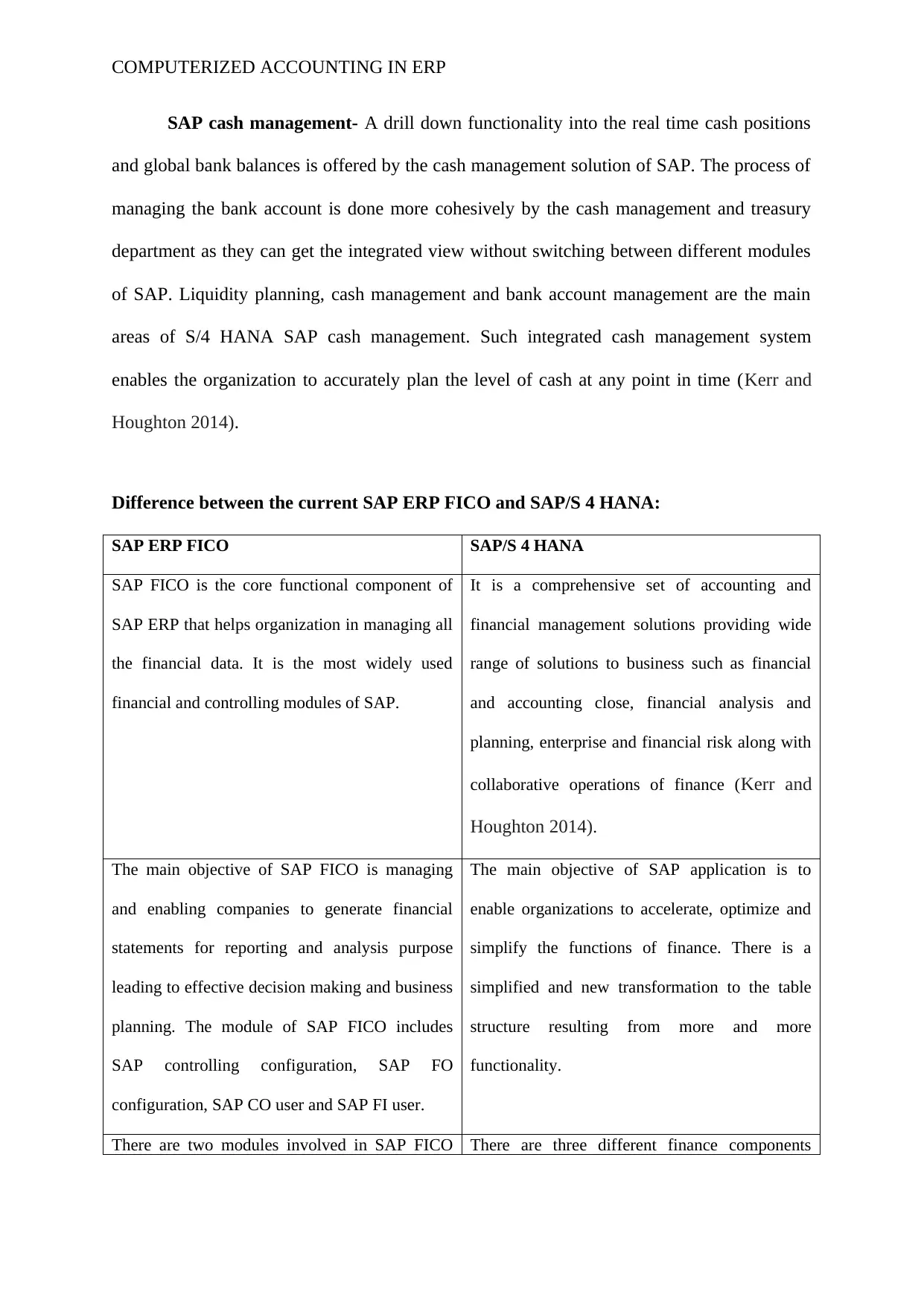
COMPUTERIZED ACCOUNTING IN ERP
SAP cash management- A drill down functionality into the real time cash positions
and global bank balances is offered by the cash management solution of SAP. The process of
managing the bank account is done more cohesively by the cash management and treasury
department as they can get the integrated view without switching between different modules
of SAP. Liquidity planning, cash management and bank account management are the main
areas of S/4 HANA SAP cash management. Such integrated cash management system
enables the organization to accurately plan the level of cash at any point in time (Kerr and
Houghton 2014).
Difference between the current SAP ERP FICO and SAP/S 4 HANA:
SAP ERP FICO SAP/S 4 HANA
SAP FICO is the core functional component of
SAP ERP that helps organization in managing all
the financial data. It is the most widely used
financial and controlling modules of SAP.
It is a comprehensive set of accounting and
financial management solutions providing wide
range of solutions to business such as financial
and accounting close, financial analysis and
planning, enterprise and financial risk along with
collaborative operations of finance (Kerr and
Houghton 2014).
The main objective of SAP FICO is managing
and enabling companies to generate financial
statements for reporting and analysis purpose
leading to effective decision making and business
planning. The module of SAP FICO includes
SAP controlling configuration, SAP FO
configuration, SAP CO user and SAP FI user.
The main objective of SAP application is to
enable organizations to accelerate, optimize and
simplify the functions of finance. There is a
simplified and new transformation to the table
structure resulting from more and more
functionality.
There are two modules involved in SAP FICO There are three different finance components
SAP cash management- A drill down functionality into the real time cash positions
and global bank balances is offered by the cash management solution of SAP. The process of
managing the bank account is done more cohesively by the cash management and treasury
department as they can get the integrated view without switching between different modules
of SAP. Liquidity planning, cash management and bank account management are the main
areas of S/4 HANA SAP cash management. Such integrated cash management system
enables the organization to accurately plan the level of cash at any point in time (Kerr and
Houghton 2014).
Difference between the current SAP ERP FICO and SAP/S 4 HANA:
SAP ERP FICO SAP/S 4 HANA
SAP FICO is the core functional component of
SAP ERP that helps organization in managing all
the financial data. It is the most widely used
financial and controlling modules of SAP.
It is a comprehensive set of accounting and
financial management solutions providing wide
range of solutions to business such as financial
and accounting close, financial analysis and
planning, enterprise and financial risk along with
collaborative operations of finance (Kerr and
Houghton 2014).
The main objective of SAP FICO is managing
and enabling companies to generate financial
statements for reporting and analysis purpose
leading to effective decision making and business
planning. The module of SAP FICO includes
SAP controlling configuration, SAP FO
configuration, SAP CO user and SAP FI user.
The main objective of SAP application is to
enable organizations to accelerate, optimize and
simplify the functions of finance. There is a
simplified and new transformation to the table
structure resulting from more and more
functionality.
There are two modules involved in SAP FICO There are three different finance components
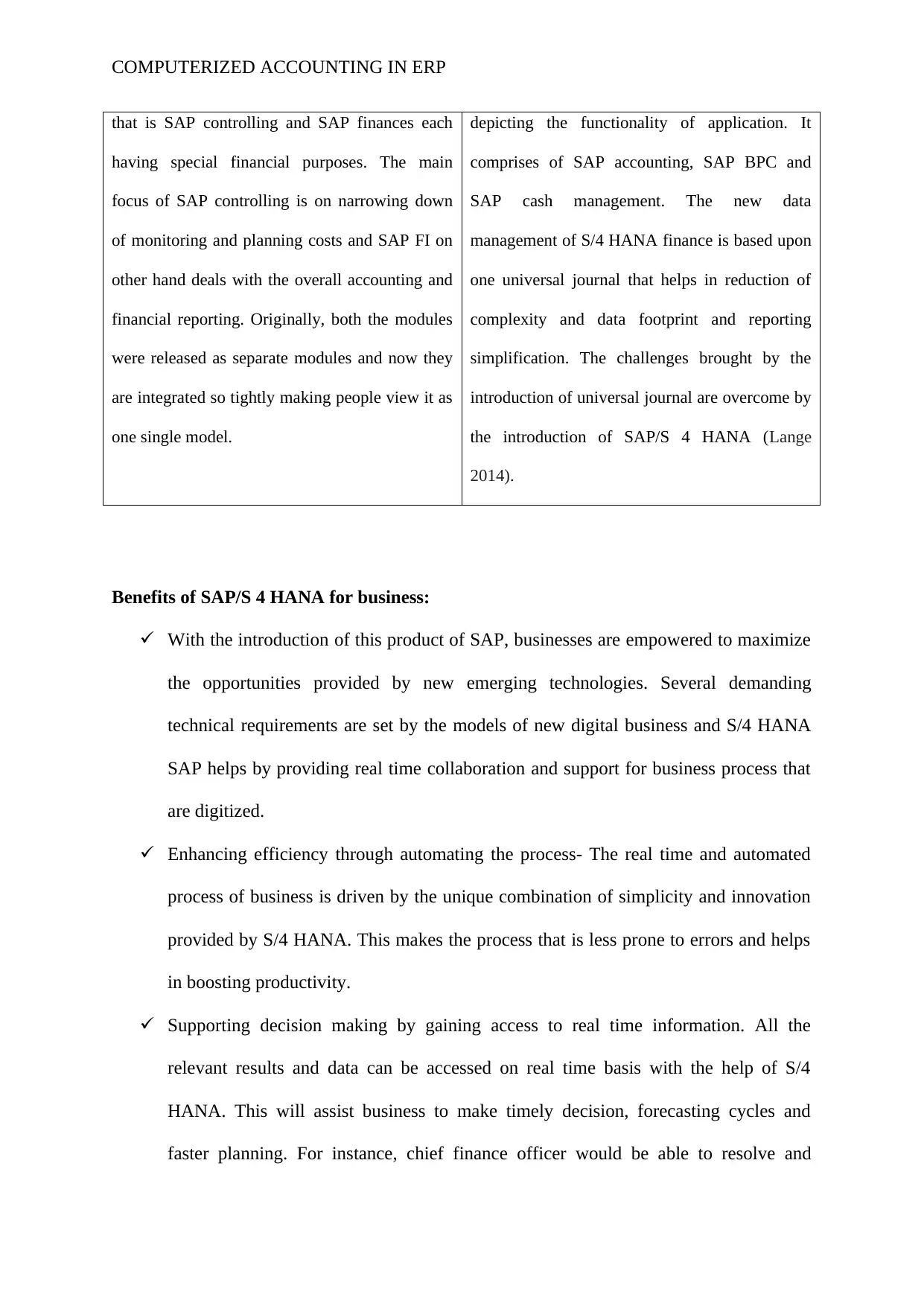
COMPUTERIZED ACCOUNTING IN ERP
that is SAP controlling and SAP finances each
having special financial purposes. The main
focus of SAP controlling is on narrowing down
of monitoring and planning costs and SAP FI on
other hand deals with the overall accounting and
financial reporting. Originally, both the modules
were released as separate modules and now they
are integrated so tightly making people view it as
one single model.
depicting the functionality of application. It
comprises of SAP accounting, SAP BPC and
SAP cash management. The new data
management of S/4 HANA finance is based upon
one universal journal that helps in reduction of
complexity and data footprint and reporting
simplification. The challenges brought by the
introduction of universal journal are overcome by
the introduction of SAP/S 4 HANA (Lange
2014).
Benefits of SAP/S 4 HANA for business:
With the introduction of this product of SAP, businesses are empowered to maximize
the opportunities provided by new emerging technologies. Several demanding
technical requirements are set by the models of new digital business and S/4 HANA
SAP helps by providing real time collaboration and support for business process that
are digitized.
Enhancing efficiency through automating the process- The real time and automated
process of business is driven by the unique combination of simplicity and innovation
provided by S/4 HANA. This makes the process that is less prone to errors and helps
in boosting productivity.
Supporting decision making by gaining access to real time information. All the
relevant results and data can be accessed on real time basis with the help of S/4
HANA. This will assist business to make timely decision, forecasting cycles and
faster planning. For instance, chief finance officer would be able to resolve and
that is SAP controlling and SAP finances each
having special financial purposes. The main
focus of SAP controlling is on narrowing down
of monitoring and planning costs and SAP FI on
other hand deals with the overall accounting and
financial reporting. Originally, both the modules
were released as separate modules and now they
are integrated so tightly making people view it as
one single model.
depicting the functionality of application. It
comprises of SAP accounting, SAP BPC and
SAP cash management. The new data
management of S/4 HANA finance is based upon
one universal journal that helps in reduction of
complexity and data footprint and reporting
simplification. The challenges brought by the
introduction of universal journal are overcome by
the introduction of SAP/S 4 HANA (Lange
2014).
Benefits of SAP/S 4 HANA for business:
With the introduction of this product of SAP, businesses are empowered to maximize
the opportunities provided by new emerging technologies. Several demanding
technical requirements are set by the models of new digital business and S/4 HANA
SAP helps by providing real time collaboration and support for business process that
are digitized.
Enhancing efficiency through automating the process- The real time and automated
process of business is driven by the unique combination of simplicity and innovation
provided by S/4 HANA. This makes the process that is less prone to errors and helps
in boosting productivity.
Supporting decision making by gaining access to real time information. All the
relevant results and data can be accessed on real time basis with the help of S/4
HANA. This will assist business to make timely decision, forecasting cycles and
faster planning. For instance, chief finance officer would be able to resolve and
Paraphrase This Document
Need a fresh take? Get an instant paraphrase of this document with our AI Paraphraser
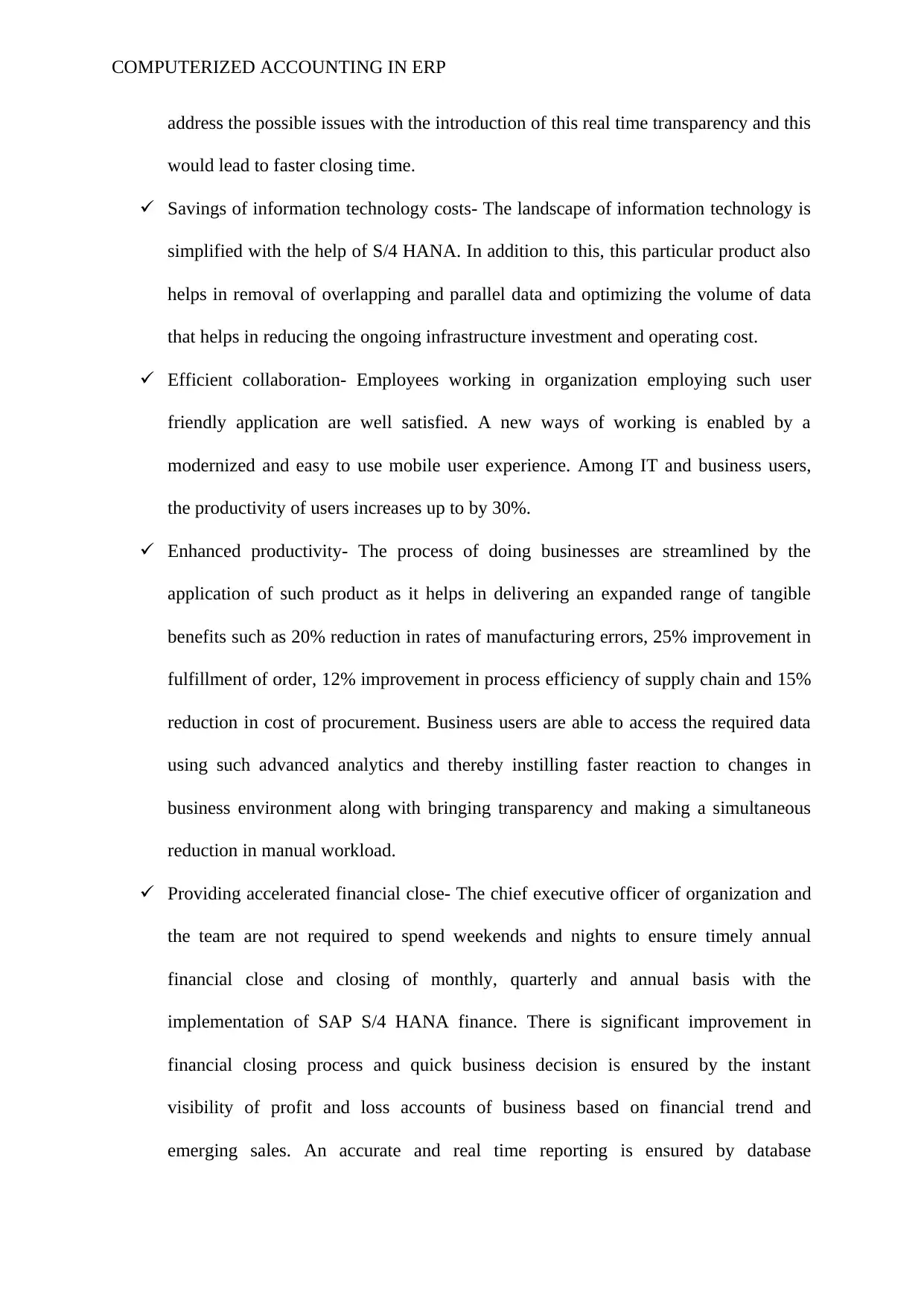
COMPUTERIZED ACCOUNTING IN ERP
address the possible issues with the introduction of this real time transparency and this
would lead to faster closing time.
Savings of information technology costs- The landscape of information technology is
simplified with the help of S/4 HANA. In addition to this, this particular product also
helps in removal of overlapping and parallel data and optimizing the volume of data
that helps in reducing the ongoing infrastructure investment and operating cost.
Efficient collaboration- Employees working in organization employing such user
friendly application are well satisfied. A new ways of working is enabled by a
modernized and easy to use mobile user experience. Among IT and business users,
the productivity of users increases up to by 30%.
Enhanced productivity- The process of doing businesses are streamlined by the
application of such product as it helps in delivering an expanded range of tangible
benefits such as 20% reduction in rates of manufacturing errors, 25% improvement in
fulfillment of order, 12% improvement in process efficiency of supply chain and 15%
reduction in cost of procurement. Business users are able to access the required data
using such advanced analytics and thereby instilling faster reaction to changes in
business environment along with bringing transparency and making a simultaneous
reduction in manual workload.
Providing accelerated financial close- The chief executive officer of organization and
the team are not required to spend weekends and nights to ensure timely annual
financial close and closing of monthly, quarterly and annual basis with the
implementation of SAP S/4 HANA finance. There is significant improvement in
financial closing process and quick business decision is ensured by the instant
visibility of profit and loss accounts of business based on financial trend and
emerging sales. An accurate and real time reporting is ensured by database
address the possible issues with the introduction of this real time transparency and this
would lead to faster closing time.
Savings of information technology costs- The landscape of information technology is
simplified with the help of S/4 HANA. In addition to this, this particular product also
helps in removal of overlapping and parallel data and optimizing the volume of data
that helps in reducing the ongoing infrastructure investment and operating cost.
Efficient collaboration- Employees working in organization employing such user
friendly application are well satisfied. A new ways of working is enabled by a
modernized and easy to use mobile user experience. Among IT and business users,
the productivity of users increases up to by 30%.
Enhanced productivity- The process of doing businesses are streamlined by the
application of such product as it helps in delivering an expanded range of tangible
benefits such as 20% reduction in rates of manufacturing errors, 25% improvement in
fulfillment of order, 12% improvement in process efficiency of supply chain and 15%
reduction in cost of procurement. Business users are able to access the required data
using such advanced analytics and thereby instilling faster reaction to changes in
business environment along with bringing transparency and making a simultaneous
reduction in manual workload.
Providing accelerated financial close- The chief executive officer of organization and
the team are not required to spend weekends and nights to ensure timely annual
financial close and closing of monthly, quarterly and annual basis with the
implementation of SAP S/4 HANA finance. There is significant improvement in
financial closing process and quick business decision is ensured by the instant
visibility of profit and loss accounts of business based on financial trend and
emerging sales. An accurate and real time reporting is ensured by database
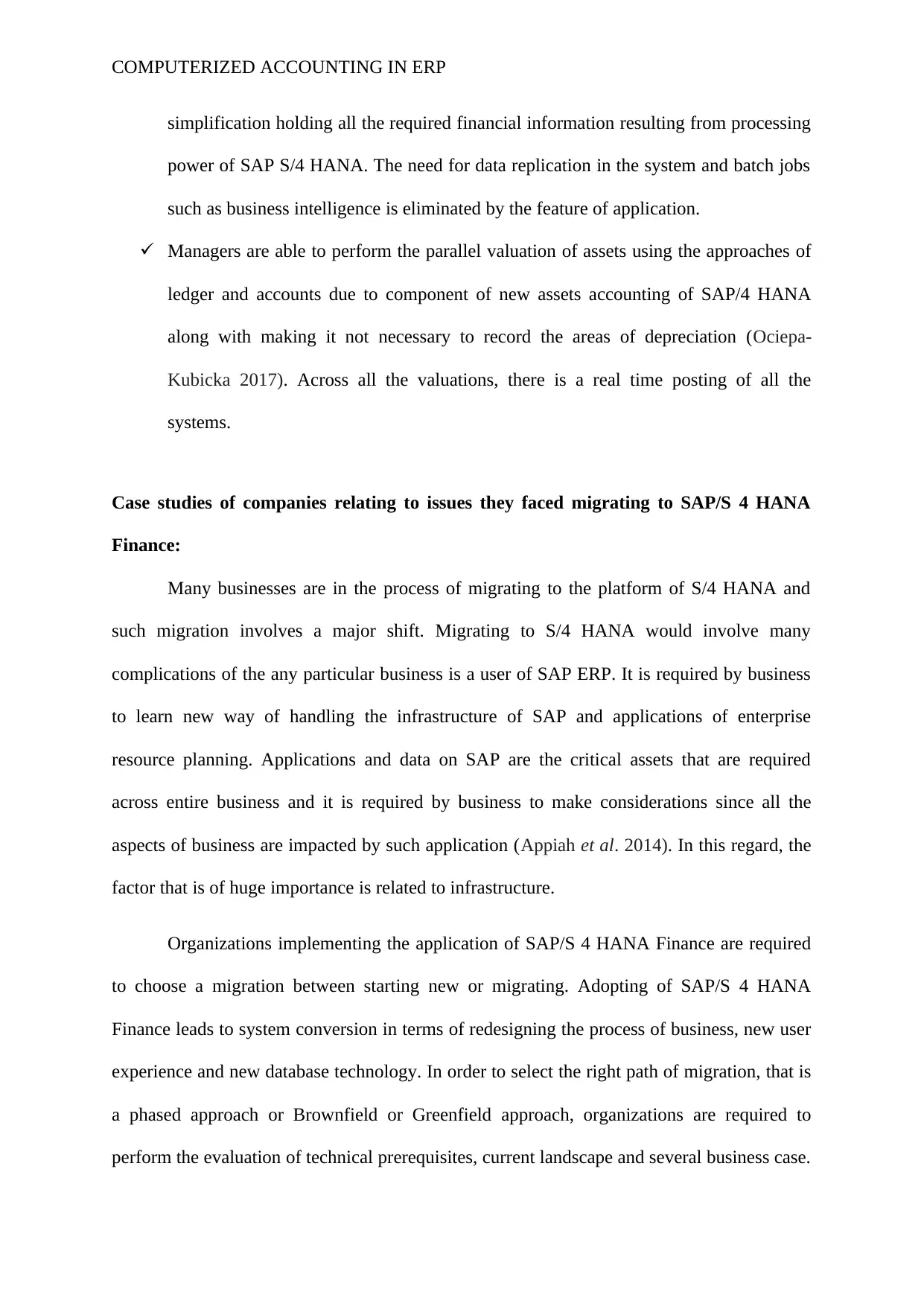
COMPUTERIZED ACCOUNTING IN ERP
simplification holding all the required financial information resulting from processing
power of SAP S/4 HANA. The need for data replication in the system and batch jobs
such as business intelligence is eliminated by the feature of application.
Managers are able to perform the parallel valuation of assets using the approaches of
ledger and accounts due to component of new assets accounting of SAP/4 HANA
along with making it not necessary to record the areas of depreciation (Ociepa-
Kubicka 2017). Across all the valuations, there is a real time posting of all the
systems.
Case studies of companies relating to issues they faced migrating to SAP/S 4 HANA
Finance:
Many businesses are in the process of migrating to the platform of S/4 HANA and
such migration involves a major shift. Migrating to S/4 HANA would involve many
complications of the any particular business is a user of SAP ERP. It is required by business
to learn new way of handling the infrastructure of SAP and applications of enterprise
resource planning. Applications and data on SAP are the critical assets that are required
across entire business and it is required by business to make considerations since all the
aspects of business are impacted by such application (Appiah et al. 2014). In this regard, the
factor that is of huge importance is related to infrastructure.
Organizations implementing the application of SAP/S 4 HANA Finance are required
to choose a migration between starting new or migrating. Adopting of SAP/S 4 HANA
Finance leads to system conversion in terms of redesigning the process of business, new user
experience and new database technology. In order to select the right path of migration, that is
a phased approach or Brownfield or Greenfield approach, organizations are required to
perform the evaluation of technical prerequisites, current landscape and several business case.
simplification holding all the required financial information resulting from processing
power of SAP S/4 HANA. The need for data replication in the system and batch jobs
such as business intelligence is eliminated by the feature of application.
Managers are able to perform the parallel valuation of assets using the approaches of
ledger and accounts due to component of new assets accounting of SAP/4 HANA
along with making it not necessary to record the areas of depreciation (Ociepa-
Kubicka 2017). Across all the valuations, there is a real time posting of all the
systems.
Case studies of companies relating to issues they faced migrating to SAP/S 4 HANA
Finance:
Many businesses are in the process of migrating to the platform of S/4 HANA and
such migration involves a major shift. Migrating to S/4 HANA would involve many
complications of the any particular business is a user of SAP ERP. It is required by business
to learn new way of handling the infrastructure of SAP and applications of enterprise
resource planning. Applications and data on SAP are the critical assets that are required
across entire business and it is required by business to make considerations since all the
aspects of business are impacted by such application (Appiah et al. 2014). In this regard, the
factor that is of huge importance is related to infrastructure.
Organizations implementing the application of SAP/S 4 HANA Finance are required
to choose a migration between starting new or migrating. Adopting of SAP/S 4 HANA
Finance leads to system conversion in terms of redesigning the process of business, new user
experience and new database technology. In order to select the right path of migration, that is
a phased approach or Brownfield or Greenfield approach, organizations are required to
perform the evaluation of technical prerequisites, current landscape and several business case.
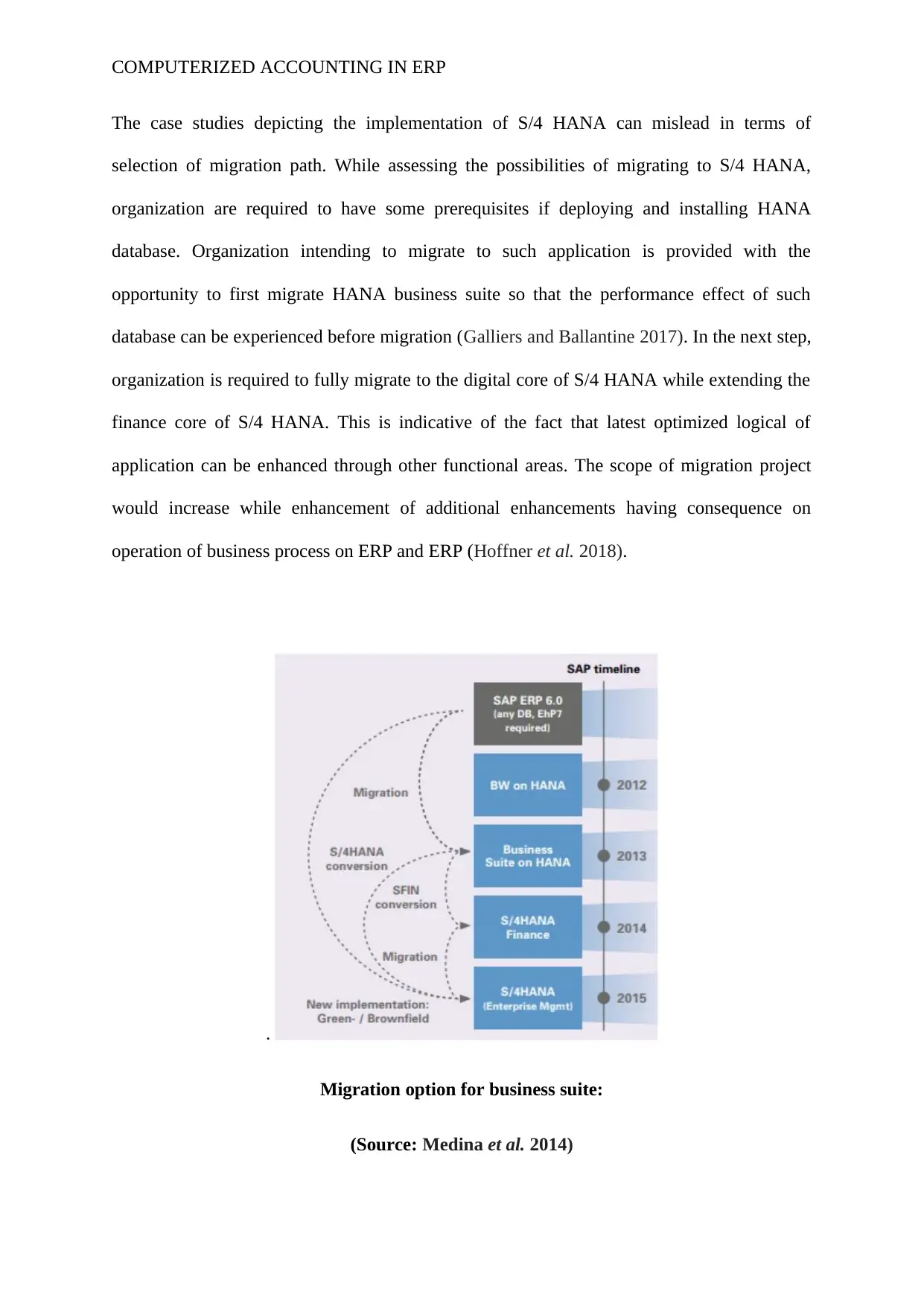
COMPUTERIZED ACCOUNTING IN ERP
The case studies depicting the implementation of S/4 HANA can mislead in terms of
selection of migration path. While assessing the possibilities of migrating to S/4 HANA,
organization are required to have some prerequisites if deploying and installing HANA
database. Organization intending to migrate to such application is provided with the
opportunity to first migrate HANA business suite so that the performance effect of such
database can be experienced before migration (Galliers and Ballantine 2017). In the next step,
organization is required to fully migrate to the digital core of S/4 HANA while extending the
finance core of S/4 HANA. This is indicative of the fact that latest optimized logical of
application can be enhanced through other functional areas. The scope of migration project
would increase while enhancement of additional enhancements having consequence on
operation of business process on ERP and ERP (Hoffner et al. 2018).
.
Migration option for business suite:
(Source: Medina et al. 2014)
The case studies depicting the implementation of S/4 HANA can mislead in terms of
selection of migration path. While assessing the possibilities of migrating to S/4 HANA,
organization are required to have some prerequisites if deploying and installing HANA
database. Organization intending to migrate to such application is provided with the
opportunity to first migrate HANA business suite so that the performance effect of such
database can be experienced before migration (Galliers and Ballantine 2017). In the next step,
organization is required to fully migrate to the digital core of S/4 HANA while extending the
finance core of S/4 HANA. This is indicative of the fact that latest optimized logical of
application can be enhanced through other functional areas. The scope of migration project
would increase while enhancement of additional enhancements having consequence on
operation of business process on ERP and ERP (Hoffner et al. 2018).
.
Migration option for business suite:
(Source: Medina et al. 2014)
Secure Best Marks with AI Grader
Need help grading? Try our AI Grader for instant feedback on your assignments.
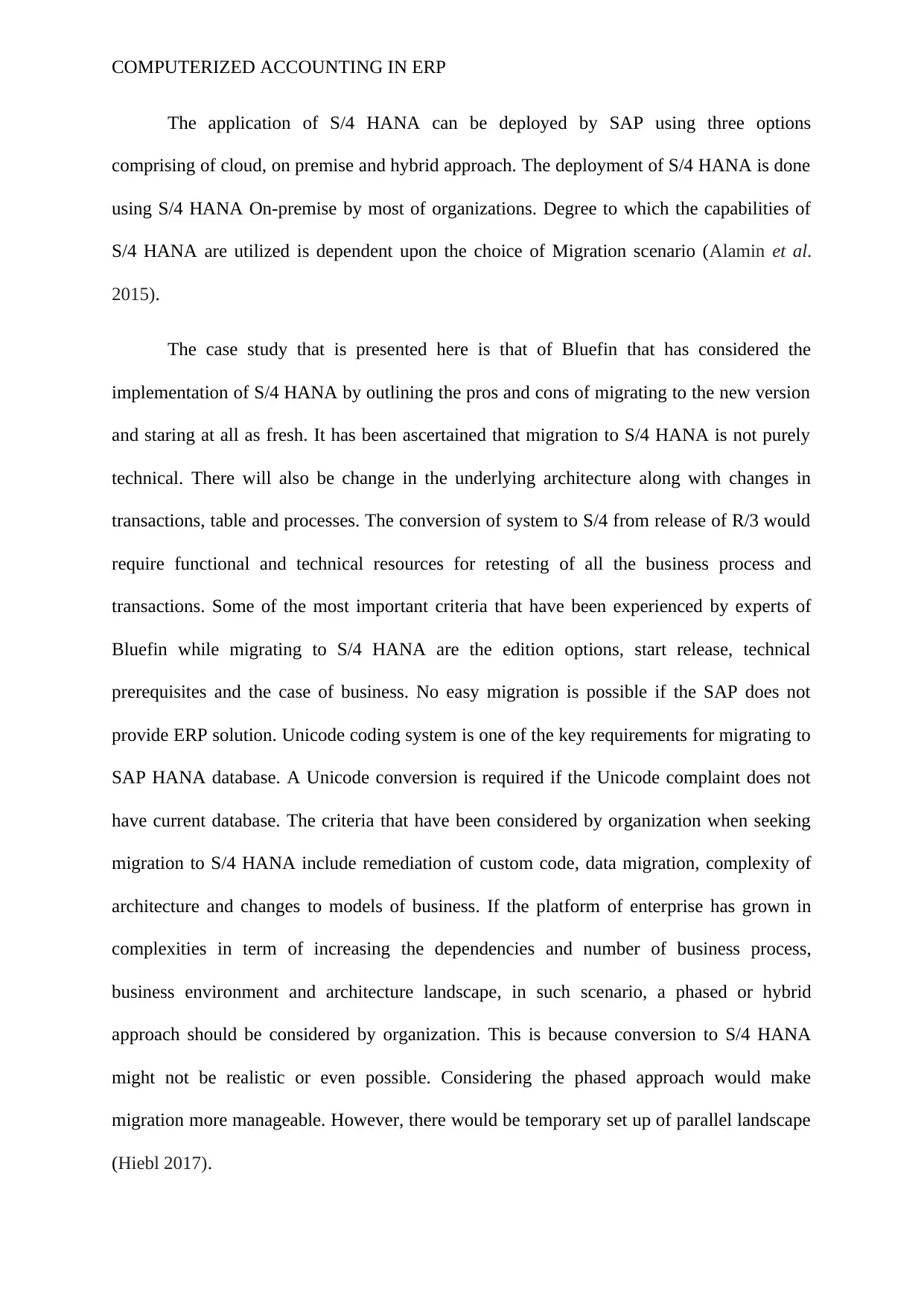
COMPUTERIZED ACCOUNTING IN ERP
The application of S/4 HANA can be deployed by SAP using three options
comprising of cloud, on premise and hybrid approach. The deployment of S/4 HANA is done
using S/4 HANA On-premise by most of organizations. Degree to which the capabilities of
S/4 HANA are utilized is dependent upon the choice of Migration scenario (Alamin et al.
2015).
The case study that is presented here is that of Bluefin that has considered the
implementation of S/4 HANA by outlining the pros and cons of migrating to the new version
and staring at all as fresh. It has been ascertained that migration to S/4 HANA is not purely
technical. There will also be change in the underlying architecture along with changes in
transactions, table and processes. The conversion of system to S/4 from release of R/3 would
require functional and technical resources for retesting of all the business process and
transactions. Some of the most important criteria that have been experienced by experts of
Bluefin while migrating to S/4 HANA are the edition options, start release, technical
prerequisites and the case of business. No easy migration is possible if the SAP does not
provide ERP solution. Unicode coding system is one of the key requirements for migrating to
SAP HANA database. A Unicode conversion is required if the Unicode complaint does not
have current database. The criteria that have been considered by organization when seeking
migration to S/4 HANA include remediation of custom code, data migration, complexity of
architecture and changes to models of business. If the platform of enterprise has grown in
complexities in term of increasing the dependencies and number of business process,
business environment and architecture landscape, in such scenario, a phased or hybrid
approach should be considered by organization. This is because conversion to S/4 HANA
might not be realistic or even possible. Considering the phased approach would make
migration more manageable. However, there would be temporary set up of parallel landscape
(Hiebl 2017).
The application of S/4 HANA can be deployed by SAP using three options
comprising of cloud, on premise and hybrid approach. The deployment of S/4 HANA is done
using S/4 HANA On-premise by most of organizations. Degree to which the capabilities of
S/4 HANA are utilized is dependent upon the choice of Migration scenario (Alamin et al.
2015).
The case study that is presented here is that of Bluefin that has considered the
implementation of S/4 HANA by outlining the pros and cons of migrating to the new version
and staring at all as fresh. It has been ascertained that migration to S/4 HANA is not purely
technical. There will also be change in the underlying architecture along with changes in
transactions, table and processes. The conversion of system to S/4 from release of R/3 would
require functional and technical resources for retesting of all the business process and
transactions. Some of the most important criteria that have been experienced by experts of
Bluefin while migrating to S/4 HANA are the edition options, start release, technical
prerequisites and the case of business. No easy migration is possible if the SAP does not
provide ERP solution. Unicode coding system is one of the key requirements for migrating to
SAP HANA database. A Unicode conversion is required if the Unicode complaint does not
have current database. The criteria that have been considered by organization when seeking
migration to S/4 HANA include remediation of custom code, data migration, complexity of
architecture and changes to models of business. If the platform of enterprise has grown in
complexities in term of increasing the dependencies and number of business process,
business environment and architecture landscape, in such scenario, a phased or hybrid
approach should be considered by organization. This is because conversion to S/4 HANA
might not be realistic or even possible. Considering the phased approach would make
migration more manageable. However, there would be temporary set up of parallel landscape
(Hiebl 2017).
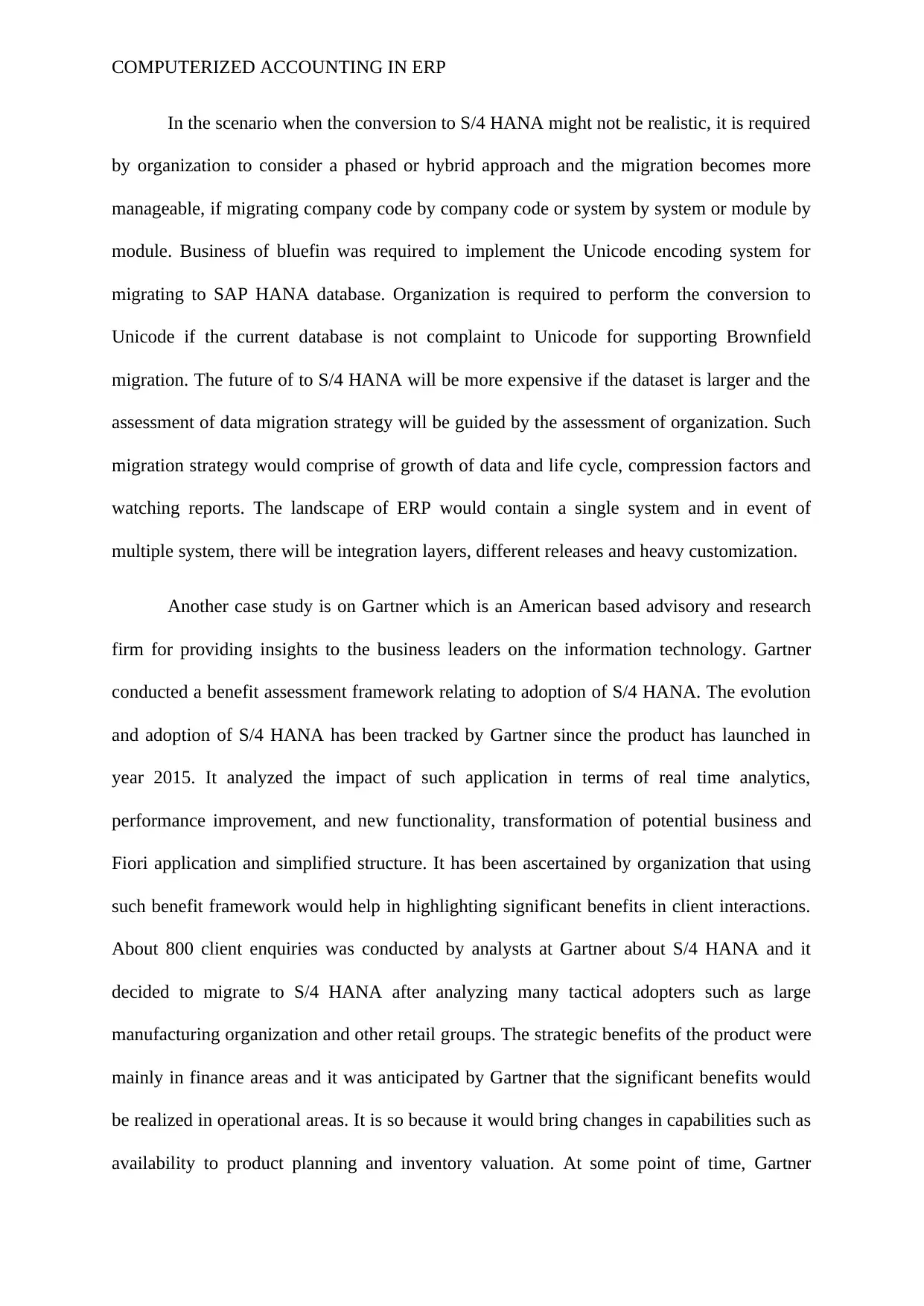
COMPUTERIZED ACCOUNTING IN ERP
In the scenario when the conversion to S/4 HANA might not be realistic, it is required
by organization to consider a phased or hybrid approach and the migration becomes more
manageable, if migrating company code by company code or system by system or module by
module. Business of bluefin was required to implement the Unicode encoding system for
migrating to SAP HANA database. Organization is required to perform the conversion to
Unicode if the current database is not complaint to Unicode for supporting Brownfield
migration. The future of to S/4 HANA will be more expensive if the dataset is larger and the
assessment of data migration strategy will be guided by the assessment of organization. Such
migration strategy would comprise of growth of data and life cycle, compression factors and
watching reports. The landscape of ERP would contain a single system and in event of
multiple system, there will be integration layers, different releases and heavy customization.
Another case study is on Gartner which is an American based advisory and research
firm for providing insights to the business leaders on the information technology. Gartner
conducted a benefit assessment framework relating to adoption of S/4 HANA. The evolution
and adoption of S/4 HANA has been tracked by Gartner since the product has launched in
year 2015. It analyzed the impact of such application in terms of real time analytics,
performance improvement, and new functionality, transformation of potential business and
Fiori application and simplified structure. It has been ascertained by organization that using
such benefit framework would help in highlighting significant benefits in client interactions.
About 800 client enquiries was conducted by analysts at Gartner about S/4 HANA and it
decided to migrate to S/4 HANA after analyzing many tactical adopters such as large
manufacturing organization and other retail groups. The strategic benefits of the product were
mainly in finance areas and it was anticipated by Gartner that the significant benefits would
be realized in operational areas. It is so because it would bring changes in capabilities such as
availability to product planning and inventory valuation. At some point of time, Gartner
In the scenario when the conversion to S/4 HANA might not be realistic, it is required
by organization to consider a phased or hybrid approach and the migration becomes more
manageable, if migrating company code by company code or system by system or module by
module. Business of bluefin was required to implement the Unicode encoding system for
migrating to SAP HANA database. Organization is required to perform the conversion to
Unicode if the current database is not complaint to Unicode for supporting Brownfield
migration. The future of to S/4 HANA will be more expensive if the dataset is larger and the
assessment of data migration strategy will be guided by the assessment of organization. Such
migration strategy would comprise of growth of data and life cycle, compression factors and
watching reports. The landscape of ERP would contain a single system and in event of
multiple system, there will be integration layers, different releases and heavy customization.
Another case study is on Gartner which is an American based advisory and research
firm for providing insights to the business leaders on the information technology. Gartner
conducted a benefit assessment framework relating to adoption of S/4 HANA. The evolution
and adoption of S/4 HANA has been tracked by Gartner since the product has launched in
year 2015. It analyzed the impact of such application in terms of real time analytics,
performance improvement, and new functionality, transformation of potential business and
Fiori application and simplified structure. It has been ascertained by organization that using
such benefit framework would help in highlighting significant benefits in client interactions.
About 800 client enquiries was conducted by analysts at Gartner about S/4 HANA and it
decided to migrate to S/4 HANA after analyzing many tactical adopters such as large
manufacturing organization and other retail groups. The strategic benefits of the product were
mainly in finance areas and it was anticipated by Gartner that the significant benefits would
be realized in operational areas. It is so because it would bring changes in capabilities such as
availability to product planning and inventory valuation. At some point of time, Gartner
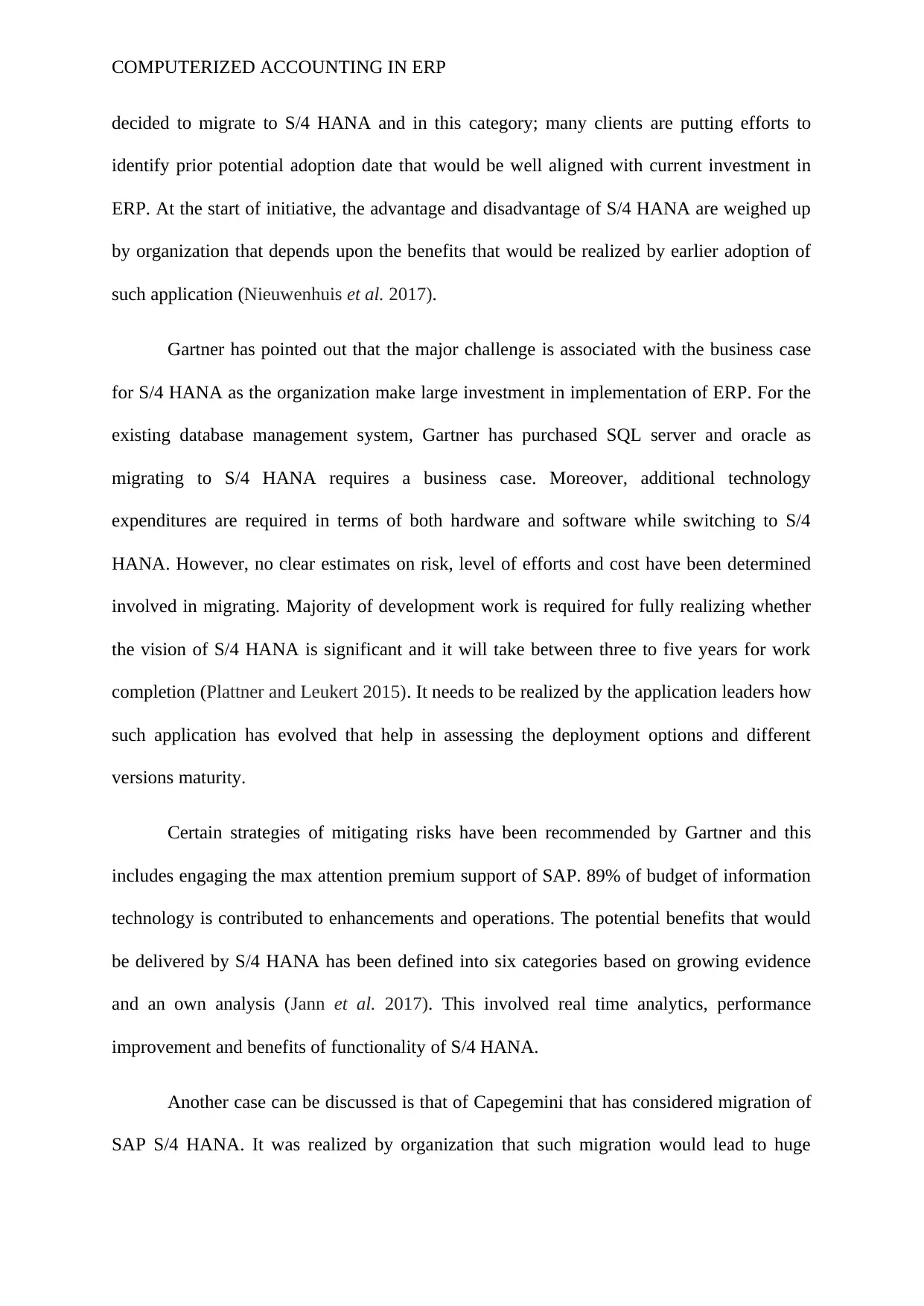
COMPUTERIZED ACCOUNTING IN ERP
decided to migrate to S/4 HANA and in this category; many clients are putting efforts to
identify prior potential adoption date that would be well aligned with current investment in
ERP. At the start of initiative, the advantage and disadvantage of S/4 HANA are weighed up
by organization that depends upon the benefits that would be realized by earlier adoption of
such application (Nieuwenhuis et al. 2017).
Gartner has pointed out that the major challenge is associated with the business case
for S/4 HANA as the organization make large investment in implementation of ERP. For the
existing database management system, Gartner has purchased SQL server and oracle as
migrating to S/4 HANA requires a business case. Moreover, additional technology
expenditures are required in terms of both hardware and software while switching to S/4
HANA. However, no clear estimates on risk, level of efforts and cost have been determined
involved in migrating. Majority of development work is required for fully realizing whether
the vision of S/4 HANA is significant and it will take between three to five years for work
completion (Plattner and Leukert 2015). It needs to be realized by the application leaders how
such application has evolved that help in assessing the deployment options and different
versions maturity.
Certain strategies of mitigating risks have been recommended by Gartner and this
includes engaging the max attention premium support of SAP. 89% of budget of information
technology is contributed to enhancements and operations. The potential benefits that would
be delivered by S/4 HANA has been defined into six categories based on growing evidence
and an own analysis (Jann et al. 2017). This involved real time analytics, performance
improvement and benefits of functionality of S/4 HANA.
Another case can be discussed is that of Capegemini that has considered migration of
SAP S/4 HANA. It was realized by organization that such migration would lead to huge
decided to migrate to S/4 HANA and in this category; many clients are putting efforts to
identify prior potential adoption date that would be well aligned with current investment in
ERP. At the start of initiative, the advantage and disadvantage of S/4 HANA are weighed up
by organization that depends upon the benefits that would be realized by earlier adoption of
such application (Nieuwenhuis et al. 2017).
Gartner has pointed out that the major challenge is associated with the business case
for S/4 HANA as the organization make large investment in implementation of ERP. For the
existing database management system, Gartner has purchased SQL server and oracle as
migrating to S/4 HANA requires a business case. Moreover, additional technology
expenditures are required in terms of both hardware and software while switching to S/4
HANA. However, no clear estimates on risk, level of efforts and cost have been determined
involved in migrating. Majority of development work is required for fully realizing whether
the vision of S/4 HANA is significant and it will take between three to five years for work
completion (Plattner and Leukert 2015). It needs to be realized by the application leaders how
such application has evolved that help in assessing the deployment options and different
versions maturity.
Certain strategies of mitigating risks have been recommended by Gartner and this
includes engaging the max attention premium support of SAP. 89% of budget of information
technology is contributed to enhancements and operations. The potential benefits that would
be delivered by S/4 HANA has been defined into six categories based on growing evidence
and an own analysis (Jann et al. 2017). This involved real time analytics, performance
improvement and benefits of functionality of S/4 HANA.
Another case can be discussed is that of Capegemini that has considered migration of
SAP S/4 HANA. It was realized by organization that such migration would lead to huge
Paraphrase This Document
Need a fresh take? Get an instant paraphrase of this document with our AI Paraphraser
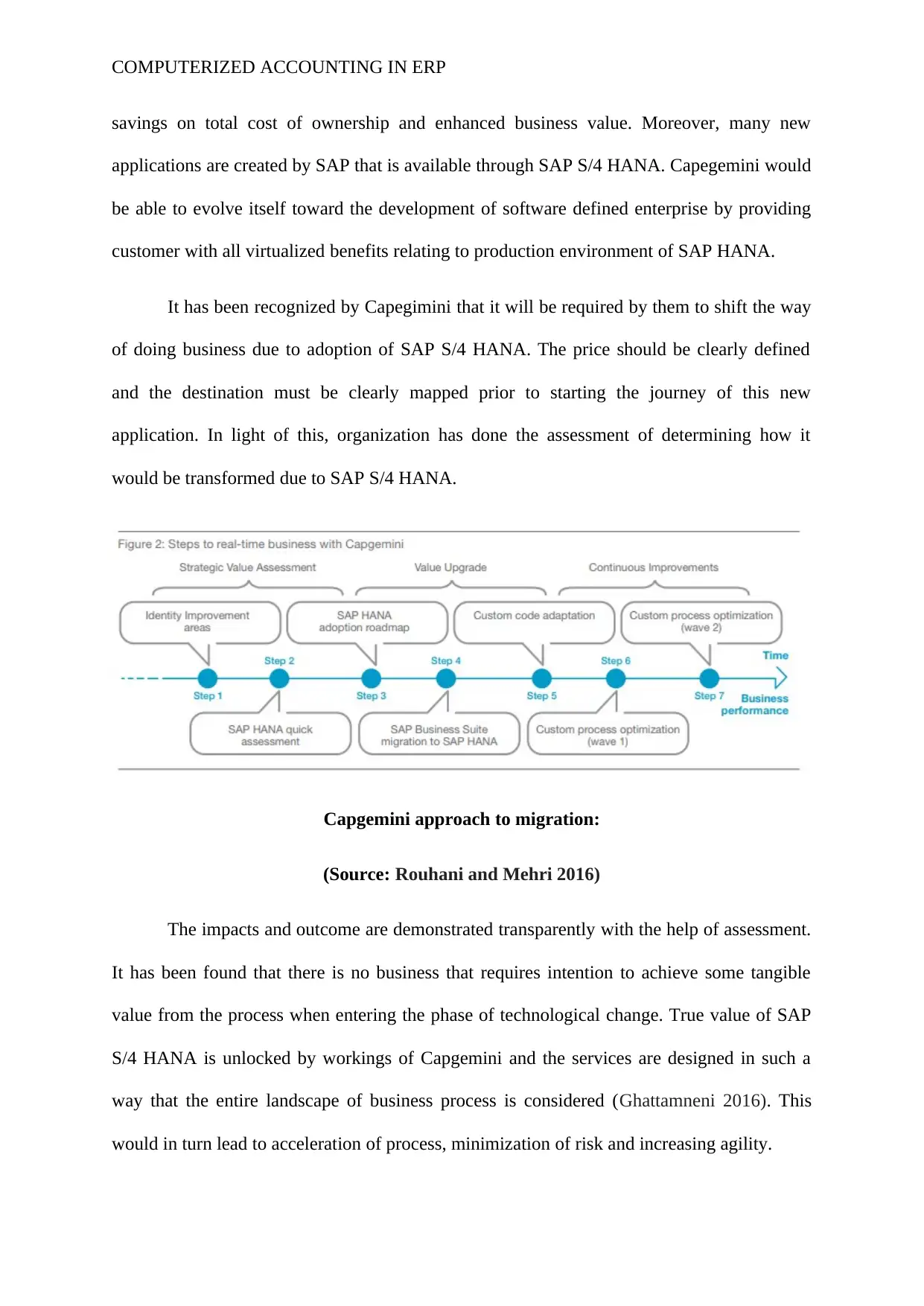
COMPUTERIZED ACCOUNTING IN ERP
savings on total cost of ownership and enhanced business value. Moreover, many new
applications are created by SAP that is available through SAP S/4 HANA. Capegemini would
be able to evolve itself toward the development of software defined enterprise by providing
customer with all virtualized benefits relating to production environment of SAP HANA.
It has been recognized by Capegimini that it will be required by them to shift the way
of doing business due to adoption of SAP S/4 HANA. The price should be clearly defined
and the destination must be clearly mapped prior to starting the journey of this new
application. In light of this, organization has done the assessment of determining how it
would be transformed due to SAP S/4 HANA.
Capgemini approach to migration:
(Source: Rouhani and Mehri 2016)
The impacts and outcome are demonstrated transparently with the help of assessment.
It has been found that there is no business that requires intention to achieve some tangible
value from the process when entering the phase of technological change. True value of SAP
S/4 HANA is unlocked by workings of Capgemini and the services are designed in such a
way that the entire landscape of business process is considered (Ghattamneni 2016). This
would in turn lead to acceleration of process, minimization of risk and increasing agility.
savings on total cost of ownership and enhanced business value. Moreover, many new
applications are created by SAP that is available through SAP S/4 HANA. Capegemini would
be able to evolve itself toward the development of software defined enterprise by providing
customer with all virtualized benefits relating to production environment of SAP HANA.
It has been recognized by Capegimini that it will be required by them to shift the way
of doing business due to adoption of SAP S/4 HANA. The price should be clearly defined
and the destination must be clearly mapped prior to starting the journey of this new
application. In light of this, organization has done the assessment of determining how it
would be transformed due to SAP S/4 HANA.
Capgemini approach to migration:
(Source: Rouhani and Mehri 2016)
The impacts and outcome are demonstrated transparently with the help of assessment.
It has been found that there is no business that requires intention to achieve some tangible
value from the process when entering the phase of technological change. True value of SAP
S/4 HANA is unlocked by workings of Capgemini and the services are designed in such a
way that the entire landscape of business process is considered (Ghattamneni 2016). This
would in turn lead to acceleration of process, minimization of risk and increasing agility.
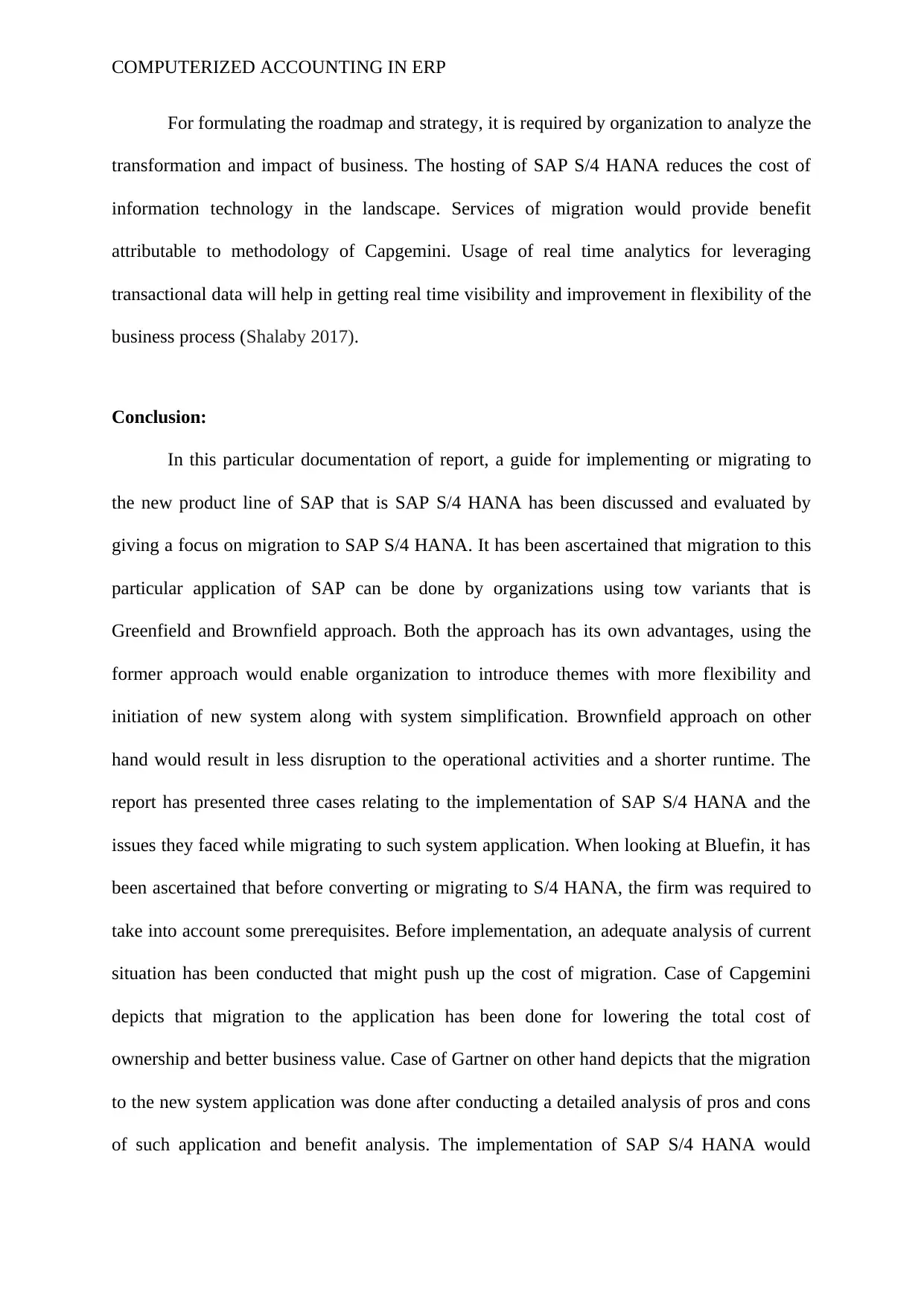
COMPUTERIZED ACCOUNTING IN ERP
For formulating the roadmap and strategy, it is required by organization to analyze the
transformation and impact of business. The hosting of SAP S/4 HANA reduces the cost of
information technology in the landscape. Services of migration would provide benefit
attributable to methodology of Capgemini. Usage of real time analytics for leveraging
transactional data will help in getting real time visibility and improvement in flexibility of the
business process (Shalaby 2017).
Conclusion:
In this particular documentation of report, a guide for implementing or migrating to
the new product line of SAP that is SAP S/4 HANA has been discussed and evaluated by
giving a focus on migration to SAP S/4 HANA. It has been ascertained that migration to this
particular application of SAP can be done by organizations using tow variants that is
Greenfield and Brownfield approach. Both the approach has its own advantages, using the
former approach would enable organization to introduce themes with more flexibility and
initiation of new system along with system simplification. Brownfield approach on other
hand would result in less disruption to the operational activities and a shorter runtime. The
report has presented three cases relating to the implementation of SAP S/4 HANA and the
issues they faced while migrating to such system application. When looking at Bluefin, it has
been ascertained that before converting or migrating to S/4 HANA, the firm was required to
take into account some prerequisites. Before implementation, an adequate analysis of current
situation has been conducted that might push up the cost of migration. Case of Capgemini
depicts that migration to the application has been done for lowering the total cost of
ownership and better business value. Case of Gartner on other hand depicts that the migration
to the new system application was done after conducting a detailed analysis of pros and cons
of such application and benefit analysis. The implementation of SAP S/4 HANA would
For formulating the roadmap and strategy, it is required by organization to analyze the
transformation and impact of business. The hosting of SAP S/4 HANA reduces the cost of
information technology in the landscape. Services of migration would provide benefit
attributable to methodology of Capgemini. Usage of real time analytics for leveraging
transactional data will help in getting real time visibility and improvement in flexibility of the
business process (Shalaby 2017).
Conclusion:
In this particular documentation of report, a guide for implementing or migrating to
the new product line of SAP that is SAP S/4 HANA has been discussed and evaluated by
giving a focus on migration to SAP S/4 HANA. It has been ascertained that migration to this
particular application of SAP can be done by organizations using tow variants that is
Greenfield and Brownfield approach. Both the approach has its own advantages, using the
former approach would enable organization to introduce themes with more flexibility and
initiation of new system along with system simplification. Brownfield approach on other
hand would result in less disruption to the operational activities and a shorter runtime. The
report has presented three cases relating to the implementation of SAP S/4 HANA and the
issues they faced while migrating to such system application. When looking at Bluefin, it has
been ascertained that before converting or migrating to S/4 HANA, the firm was required to
take into account some prerequisites. Before implementation, an adequate analysis of current
situation has been conducted that might push up the cost of migration. Case of Capgemini
depicts that migration to the application has been done for lowering the total cost of
ownership and better business value. Case of Gartner on other hand depicts that the migration
to the new system application was done after conducting a detailed analysis of pros and cons
of such application and benefit analysis. The implementation of SAP S/4 HANA would

COMPUTERIZED ACCOUNTING IN ERP
provide organization with wide range of benefits in terms of impact of transformation and
other potential benefits in areas of finance.
provide organization with wide range of benefits in terms of impact of transformation and
other potential benefits in areas of finance.
Secure Best Marks with AI Grader
Need help grading? Try our AI Grader for instant feedback on your assignments.
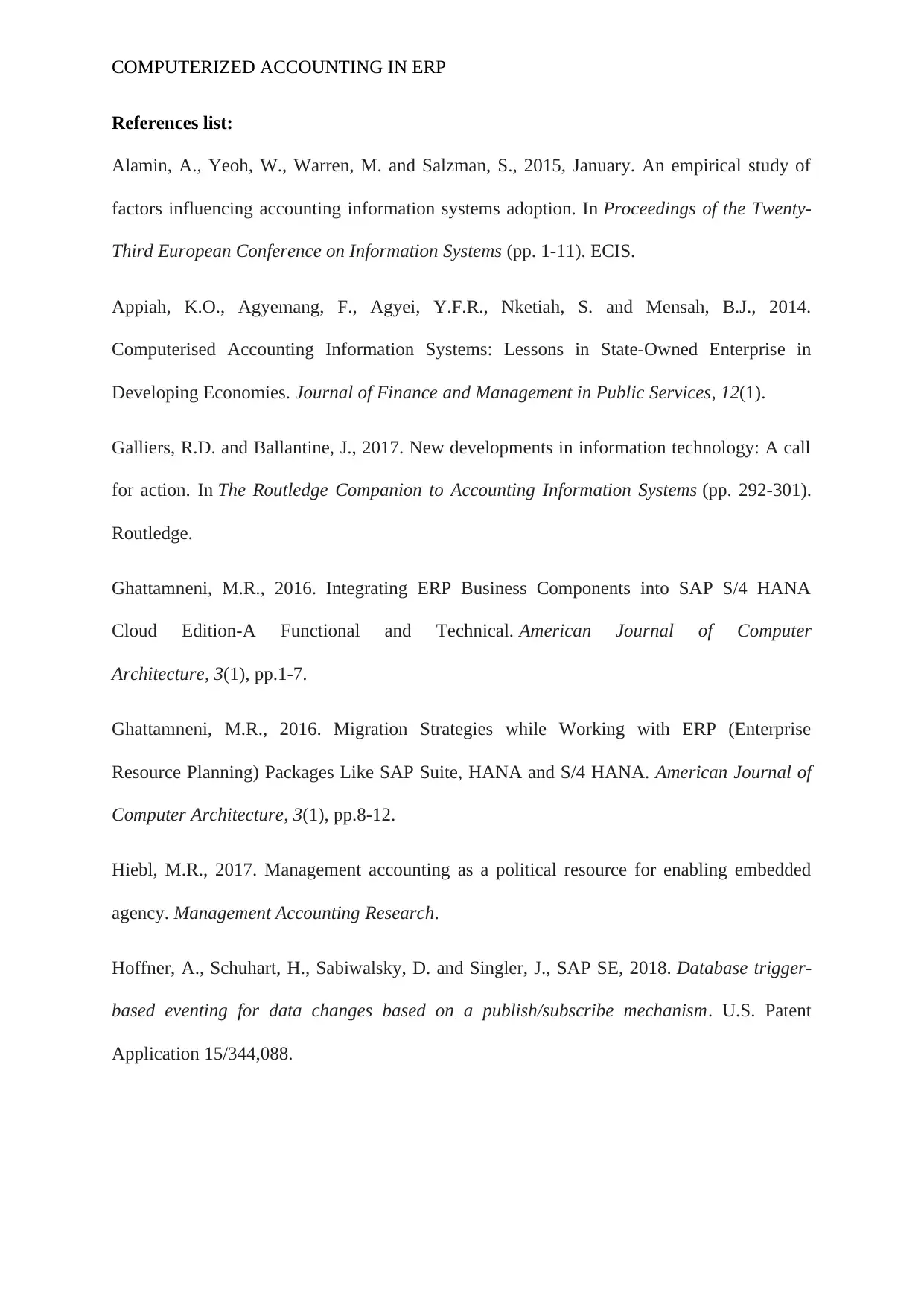
COMPUTERIZED ACCOUNTING IN ERP
References list:
Alamin, A., Yeoh, W., Warren, M. and Salzman, S., 2015, January. An empirical study of
factors influencing accounting information systems adoption. In Proceedings of the Twenty-
Third European Conference on Information Systems (pp. 1-11). ECIS.
Appiah, K.O., Agyemang, F., Agyei, Y.F.R., Nketiah, S. and Mensah, B.J., 2014.
Computerised Accounting Information Systems: Lessons in State-Owned Enterprise in
Developing Economies. Journal of Finance and Management in Public Services, 12(1).
Galliers, R.D. and Ballantine, J., 2017. New developments in information technology: A call
for action. In The Routledge Companion to Accounting Information Systems (pp. 292-301).
Routledge.
Ghattamneni, M.R., 2016. Integrating ERP Business Components into SAP S/4 HANA
Cloud Edition-A Functional and Technical. American Journal of Computer
Architecture, 3(1), pp.1-7.
Ghattamneni, M.R., 2016. Migration Strategies while Working with ERP (Enterprise
Resource Planning) Packages Like SAP Suite, HANA and S/4 HANA. American Journal of
Computer Architecture, 3(1), pp.8-12.
Hiebl, M.R., 2017. Management accounting as a political resource for enabling embedded
agency. Management Accounting Research.
Hoffner, A., Schuhart, H., Sabiwalsky, D. and Singler, J., SAP SE, 2018. Database trigger-
based eventing for data changes based on a publish/subscribe mechanism. U.S. Patent
Application 15/344,088.
References list:
Alamin, A., Yeoh, W., Warren, M. and Salzman, S., 2015, January. An empirical study of
factors influencing accounting information systems adoption. In Proceedings of the Twenty-
Third European Conference on Information Systems (pp. 1-11). ECIS.
Appiah, K.O., Agyemang, F., Agyei, Y.F.R., Nketiah, S. and Mensah, B.J., 2014.
Computerised Accounting Information Systems: Lessons in State-Owned Enterprise in
Developing Economies. Journal of Finance and Management in Public Services, 12(1).
Galliers, R.D. and Ballantine, J., 2017. New developments in information technology: A call
for action. In The Routledge Companion to Accounting Information Systems (pp. 292-301).
Routledge.
Ghattamneni, M.R., 2016. Integrating ERP Business Components into SAP S/4 HANA
Cloud Edition-A Functional and Technical. American Journal of Computer
Architecture, 3(1), pp.1-7.
Ghattamneni, M.R., 2016. Migration Strategies while Working with ERP (Enterprise
Resource Planning) Packages Like SAP Suite, HANA and S/4 HANA. American Journal of
Computer Architecture, 3(1), pp.8-12.
Hiebl, M.R., 2017. Management accounting as a political resource for enabling embedded
agency. Management Accounting Research.
Hoffner, A., Schuhart, H., Sabiwalsky, D. and Singler, J., SAP SE, 2018. Database trigger-
based eventing for data changes based on a publish/subscribe mechanism. U.S. Patent
Application 15/344,088.
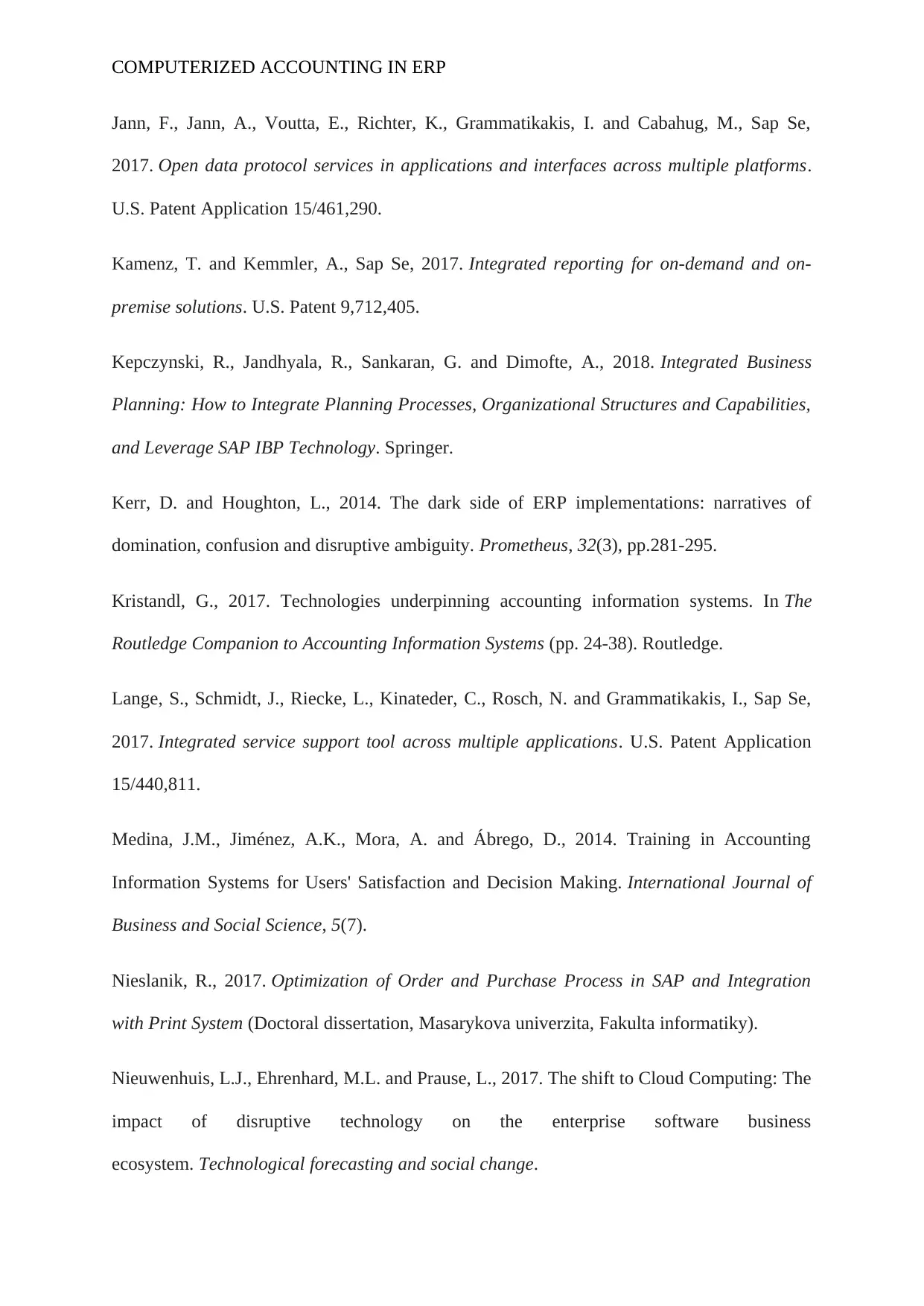
COMPUTERIZED ACCOUNTING IN ERP
Jann, F., Jann, A., Voutta, E., Richter, K., Grammatikakis, I. and Cabahug, M., Sap Se,
2017. Open data protocol services in applications and interfaces across multiple platforms.
U.S. Patent Application 15/461,290.
Kamenz, T. and Kemmler, A., Sap Se, 2017. Integrated reporting for on-demand and on-
premise solutions. U.S. Patent 9,712,405.
Kepczynski, R., Jandhyala, R., Sankaran, G. and Dimofte, A., 2018. Integrated Business
Planning: How to Integrate Planning Processes, Organizational Structures and Capabilities,
and Leverage SAP IBP Technology. Springer.
Kerr, D. and Houghton, L., 2014. The dark side of ERP implementations: narratives of
domination, confusion and disruptive ambiguity. Prometheus, 32(3), pp.281-295.
Kristandl, G., 2017. Technologies underpinning accounting information systems. In The
Routledge Companion to Accounting Information Systems (pp. 24-38). Routledge.
Lange, S., Schmidt, J., Riecke, L., Kinateder, C., Rosch, N. and Grammatikakis, I., Sap Se,
2017. Integrated service support tool across multiple applications. U.S. Patent Application
15/440,811.
Medina, J.M., Jiménez, A.K., Mora, A. and Ábrego, D., 2014. Training in Accounting
Information Systems for Users' Satisfaction and Decision Making. International Journal of
Business and Social Science, 5(7).
Nieslanik, R., 2017. Optimization of Order and Purchase Process in SAP and Integration
with Print System (Doctoral dissertation, Masarykova univerzita, Fakulta informatiky).
Nieuwenhuis, L.J., Ehrenhard, M.L. and Prause, L., 2017. The shift to Cloud Computing: The
impact of disruptive technology on the enterprise software business
ecosystem. Technological forecasting and social change.
Jann, F., Jann, A., Voutta, E., Richter, K., Grammatikakis, I. and Cabahug, M., Sap Se,
2017. Open data protocol services in applications and interfaces across multiple platforms.
U.S. Patent Application 15/461,290.
Kamenz, T. and Kemmler, A., Sap Se, 2017. Integrated reporting for on-demand and on-
premise solutions. U.S. Patent 9,712,405.
Kepczynski, R., Jandhyala, R., Sankaran, G. and Dimofte, A., 2018. Integrated Business
Planning: How to Integrate Planning Processes, Organizational Structures and Capabilities,
and Leverage SAP IBP Technology. Springer.
Kerr, D. and Houghton, L., 2014. The dark side of ERP implementations: narratives of
domination, confusion and disruptive ambiguity. Prometheus, 32(3), pp.281-295.
Kristandl, G., 2017. Technologies underpinning accounting information systems. In The
Routledge Companion to Accounting Information Systems (pp. 24-38). Routledge.
Lange, S., Schmidt, J., Riecke, L., Kinateder, C., Rosch, N. and Grammatikakis, I., Sap Se,
2017. Integrated service support tool across multiple applications. U.S. Patent Application
15/440,811.
Medina, J.M., Jiménez, A.K., Mora, A. and Ábrego, D., 2014. Training in Accounting
Information Systems for Users' Satisfaction and Decision Making. International Journal of
Business and Social Science, 5(7).
Nieslanik, R., 2017. Optimization of Order and Purchase Process in SAP and Integration
with Print System (Doctoral dissertation, Masarykova univerzita, Fakulta informatiky).
Nieuwenhuis, L.J., Ehrenhard, M.L. and Prause, L., 2017. The shift to Cloud Computing: The
impact of disruptive technology on the enterprise software business
ecosystem. Technological forecasting and social change.
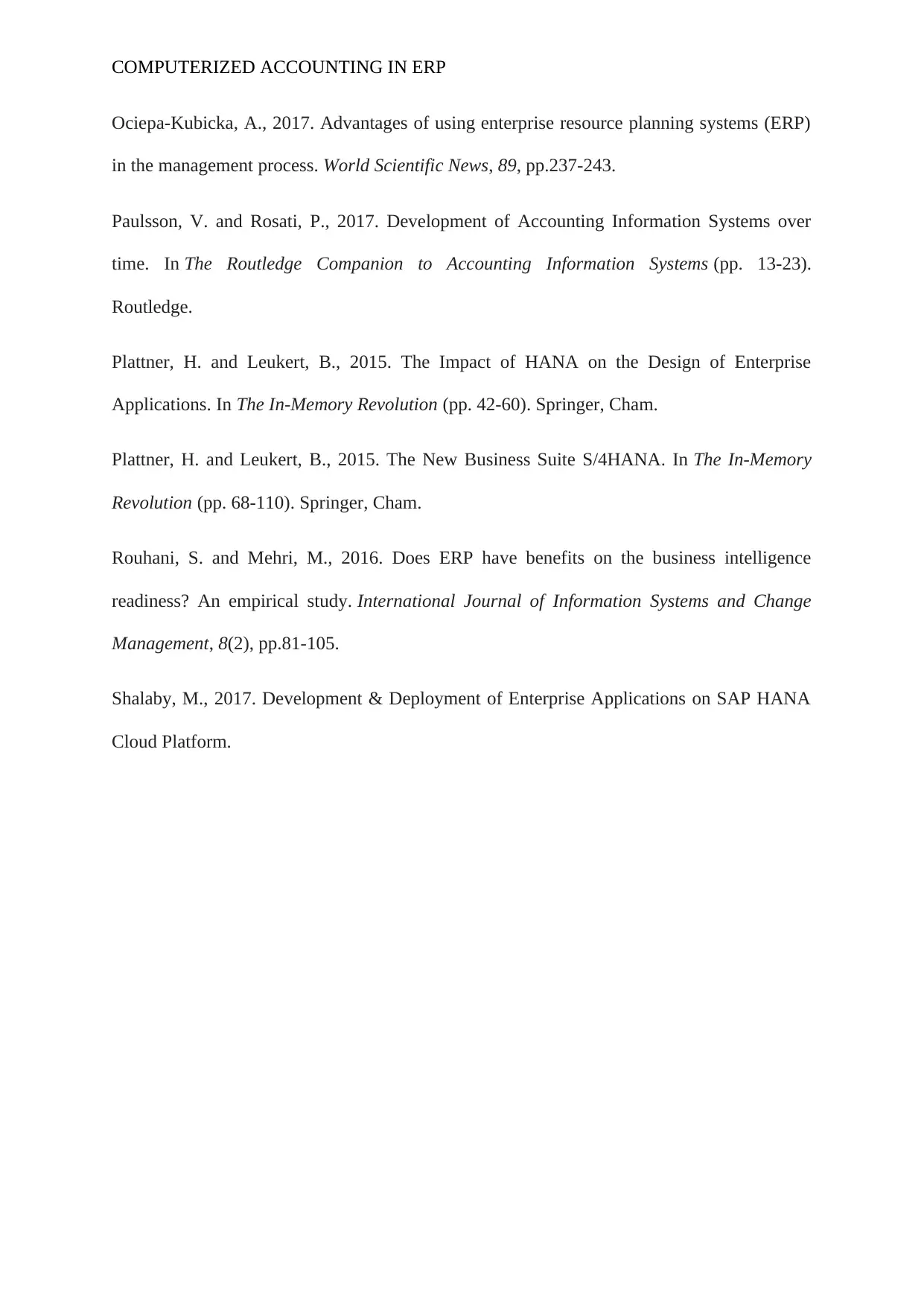
COMPUTERIZED ACCOUNTING IN ERP
Ociepa-Kubicka, A., 2017. Advantages of using enterprise resource planning systems (ERP)
in the management process. World Scientific News, 89, pp.237-243.
Paulsson, V. and Rosati, P., 2017. Development of Accounting Information Systems over
time. In The Routledge Companion to Accounting Information Systems (pp. 13-23).
Routledge.
Plattner, H. and Leukert, B., 2015. The Impact of HANA on the Design of Enterprise
Applications. In The In-Memory Revolution (pp. 42-60). Springer, Cham.
Plattner, H. and Leukert, B., 2015. The New Business Suite S/4HANA. In The In-Memory
Revolution (pp. 68-110). Springer, Cham.
Rouhani, S. and Mehri, M., 2016. Does ERP have benefits on the business intelligence
readiness? An empirical study. International Journal of Information Systems and Change
Management, 8(2), pp.81-105.
Shalaby, M., 2017. Development & Deployment of Enterprise Applications on SAP HANA
Cloud Platform.
Ociepa-Kubicka, A., 2017. Advantages of using enterprise resource planning systems (ERP)
in the management process. World Scientific News, 89, pp.237-243.
Paulsson, V. and Rosati, P., 2017. Development of Accounting Information Systems over
time. In The Routledge Companion to Accounting Information Systems (pp. 13-23).
Routledge.
Plattner, H. and Leukert, B., 2015. The Impact of HANA on the Design of Enterprise
Applications. In The In-Memory Revolution (pp. 42-60). Springer, Cham.
Plattner, H. and Leukert, B., 2015. The New Business Suite S/4HANA. In The In-Memory
Revolution (pp. 68-110). Springer, Cham.
Rouhani, S. and Mehri, M., 2016. Does ERP have benefits on the business intelligence
readiness? An empirical study. International Journal of Information Systems and Change
Management, 8(2), pp.81-105.
Shalaby, M., 2017. Development & Deployment of Enterprise Applications on SAP HANA
Cloud Platform.
1 out of 19
Related Documents
Your All-in-One AI-Powered Toolkit for Academic Success.
+13062052269
info@desklib.com
Available 24*7 on WhatsApp / Email
![[object Object]](/_next/static/media/star-bottom.7253800d.svg)
Unlock your academic potential
© 2024 | Zucol Services PVT LTD | All rights reserved.





